The post The 5 Ways to Read The Directions to Happiness by Bruce Northam appeared first on The Expeditioner Travel Site.
]]>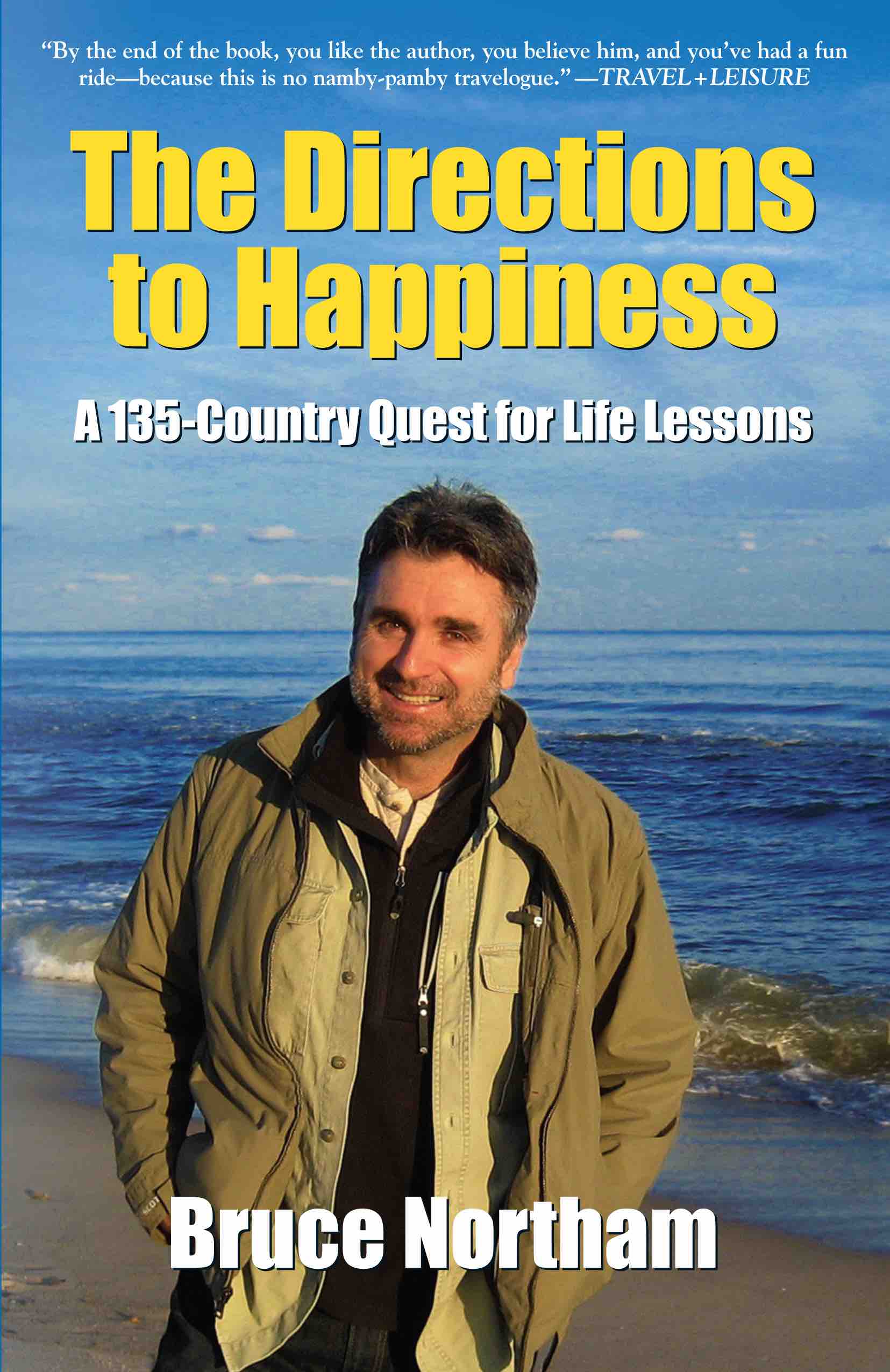
At the not-very-tender age of 35, travel writer Bruce Northam hitchhiked America from coast to coast one more time to bring awareness to the fact that it could still be done in spite of the negative P.R. the practice was receiving in the ’90s. By that time, Bruce had already been hitchhiking for two decades. His new book, The Directions to Happiness, is a lifetime of accumulated lessons given across his 30 years spent traveling in and out of 135 different countries. His “country math” was done reluctantly. As he told me, “Roaming the world should be a matter of art, not math.”
Having been able to count this New York-based author as a beer-drinking buddy of mine for the last two years, I knew I was in for some good storytelling when I loaded his latest book onto my Kindle. What I hadn’t anticipated was an integral guide that offered a thorough narrative and a compelling blueprint for finding purpose and meaning as a modern nomad.
The earnest travel wisdom coursing throughout the narrative is the sort you can’t get without spending a life on the road. Bruce is unafraid of alluding to his “vicier” days of youthful rambling, and he is unapologetic when he shares with his readers his fears the Internet culture might be fatally toxic to travel writing.
Bruce’s mischief-making followed him well past the age when most people in his age bracket begin dreaming about early retirement from the cubicles that could never hold him. He begins his narrative with tales from a childhood similar to the one led by Calvin from Calvin and Hobbes. He ends decades and 135 countries later, not owning a second home, but happy; still traveling, but settled enough to raise his daughter and to care for his aging parents.
The Directions to Happiness passes through a number of levels, from nodding wisdom to intoxicated hilarity. If you’ve been anywhere, odds are you’ll get to read about those places through Bruce’s unique lens.
Here are five ways in which the book makes a particularly compelling read.
1) The Directions of Happiness Should be Required Reading for Aspiring Travel Writers
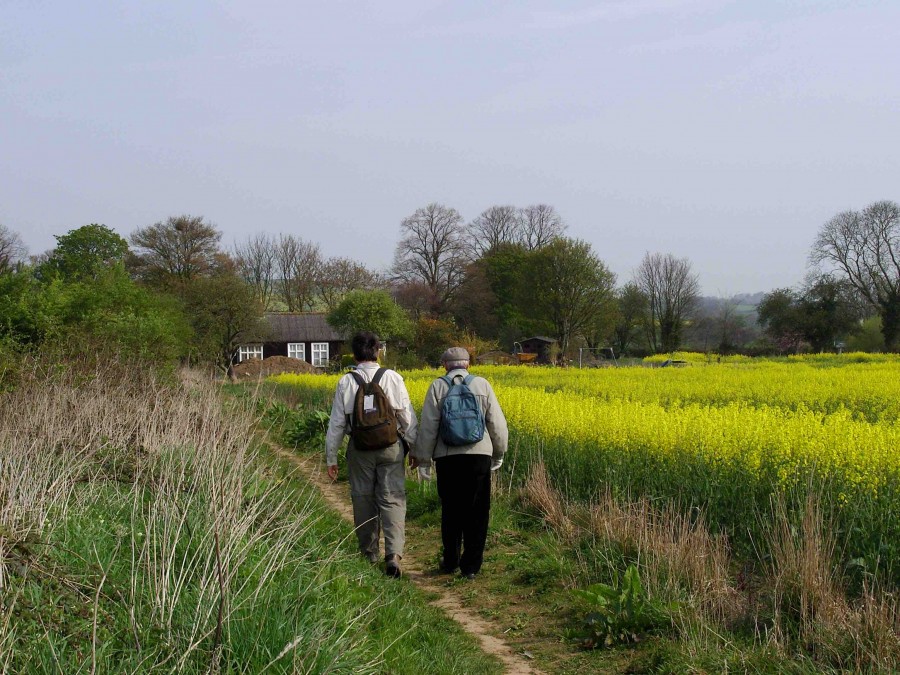
Bruce writes, “Nobody learns how to be a writer, nor a traveler. You make it happen.” Three years on, I’m still doing that, and at a certain point in the book, I stopped to take serious note. Bruce’s story is the story of a travel writer who made it. During the course of his three previously published books, he passed from varying states of financial stability, but he never gave up the fight — he was having too good a time.
“Writing about travel won’t win most fame or fortune, but it can send you and your pen to corners of the world that inspire alternative outlooks on life’s choices.” I read somewhere once that contentment is the measurement of having lived in a way that you’re proud of. The message of the book is clear: Bruce is certain he has made the right choice, and he knows he could never have found happiness by having lived any other way.
Bruce came to realize that a road well traveled and story well written were rewards of the highest rank. For me, this message is encouraging. Beyond encouragement, Bruce gives travel writers a lesson on how to be a travel writer while still providing an authentic voice. This is an important lesson today, especially given an Internet culture that seems to constantly be screaming: “Look at me!”
Throughout the book, he’s keenly aware how travel writing is changing, and he’s not thrilled that “[t]he explosion of travel content creators, especially on the web, forever changed the game. Some, who never muddy their shoes, are simply rewriting press releases where nobody ever seems to get robbed, conned, injured or laid.”
If you would like to live off travel and writing, and don’t want to contribute to international irresponsibility, this book offers an important viewpoint.
2) Read The Directions to Happiness as a Best Practices Guide to Cultural Travel
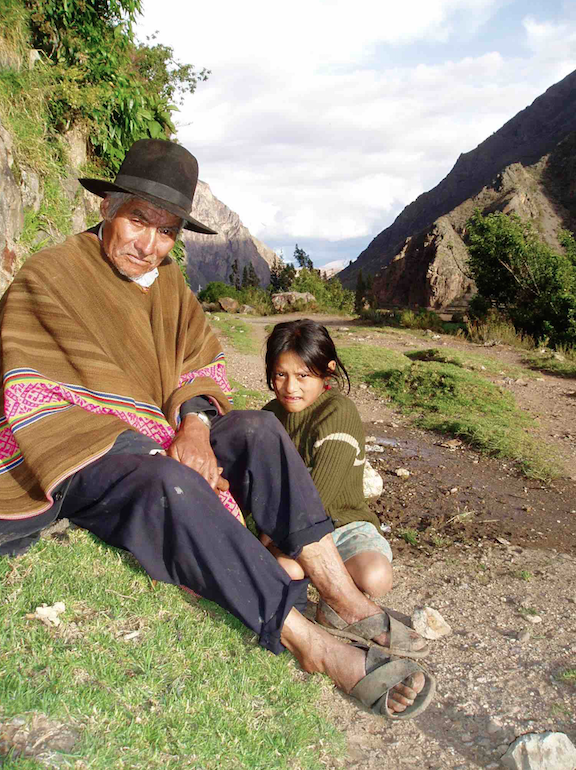
There are, in fact, right and wrong ways to travel. If you don’t think so, guess where you fall? Beyond rarely productive carbon footprint calculations, there’s a way to interact with locals where both the visitor and the visited come away better as a result of the meeting. Bruce interacts with locals as a grateful guest and offers the wisdom accumulated from these interactions.
“Don’t spend time, enjoy it,” a musician in Mozambique once told him.
“Your best teacher is your last mistake,” he learned from a Shaman in Peru.
Part of entering into another person’s world is fully leaving the world you’ve left. Bruce’s life on the road led him to see first-hand how traveling changed when Internet-connected devices started filling everyone’s packing list. This bums Bruce out. He’s not preachy, but he simply wants people to know how much better their trips will be if they “[u]nplug every now and then.”
3)Read The Directions to Happiness as a Guide on Volunteerism and Sustainable Travel
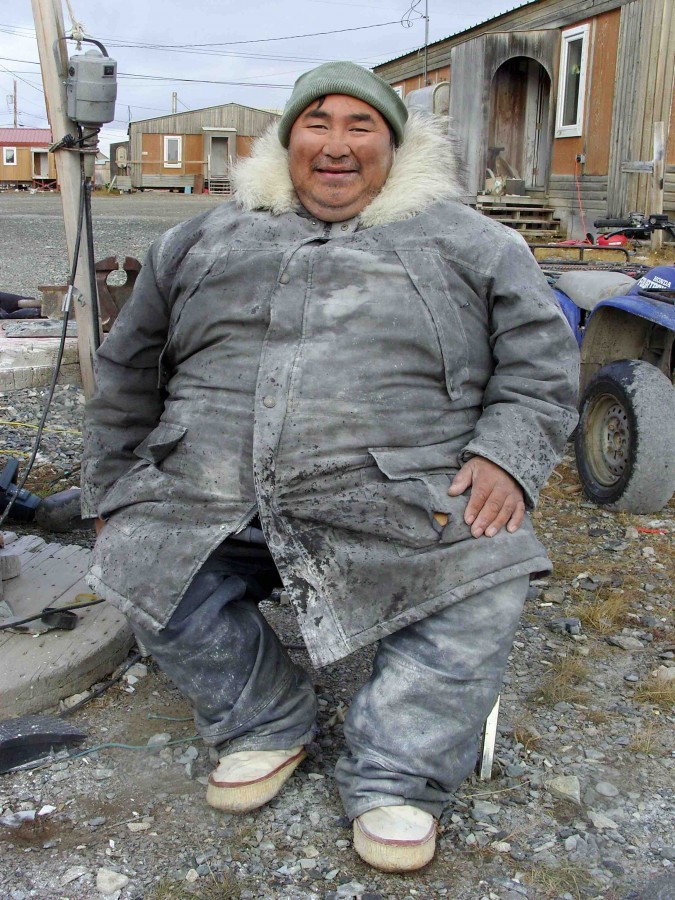
With the permission of the administration, Bruce has waltzed into many an elementary school around the world and commandeered a classroom to serve as the student’s guest teacher for a day. He has also spent time with orphanages and empowered NGOs around the world.
The lesson from this is that we don’t always need to work with a charity to make a meaningful difference, but neither do we need to shun charities. Living itself lends itself to countless human interactions, which we can steer towards positivity or negativity.
This mentality should be central to anyone dreaming of making a difference abroad. It leads to an important starting question: “Am I making a difference where I am right now with everyone I encounter?”
4) Read The Directions to Happiness As a Guide to Modern Nomadism

Living out of your suitcase isn’t always an endless adventure. Sometimes it’s hopelessly dirty underwear and troubling parasites. Considering the downsides, which include irrational fevers in lands where medicine hasn’t progressed much beyond the Middle Ages, the upsides must be truly marveling for so many people to consider a life on the road a dream life.
Living on the road teaches you there are quite a few of us out here, and while we all think our lives are awesome, we live them in defiantly different ways. When starting out, it’s important to consult those who made it out on the other side sane and not living in a cardboard box. Though I’d be the first to defend an insanity plea from Bruce, he’s certainly not living in a cardboard house beneath a bridge. Nomads, take notes.
5) Travel Philosophy as Found in The Directions to Happiness
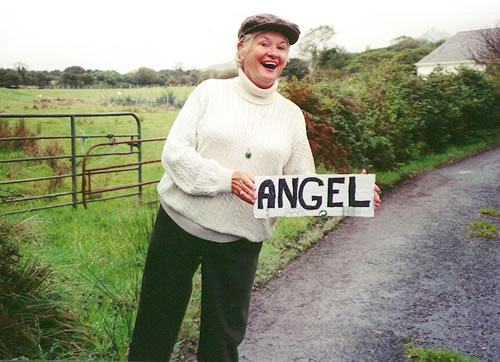
If you’ve ever read the complete works of any travel writer (or career writer for that matter), there comes a point in their career where their life philosophy progresses from fluid to established and somewhat certain. This is when they can really begin to impart their own travel philosophy to those still in their formative stage.
Bruce’s travel philosophy is a patient, non-judgmental one. He alludes to his wilder moments and reminds travelers to cherish each moment, place and person.
At one point, I stopped to reflect after reading the following passage: “Traveling makes people feel better not just because of the escapades to be had in new horizons, but also because we’re re-triggered to share our life story — and hear someone else’s.”
Living on the road, I take this fact for granted. Basically, everyday, I meet someone new, hear their 30-second elevator speech on who they are, and then I tell my own. I began to wonder: How has this impacted the people I’ve met?
*
In his epilogue, Bruce writes about how his biggest lesson compiling the book was the realization that a person living in one village for a lifetime often stumbles upon the same lofty wisdom that has taken civilizations centuries to realize.
“Someday we’re all going to realize we’re in this together,” Bruce writes. The road to get there may just be paved by those with worn soles because, “[b]roadminded, non-political solutions to the continuous warfare creeping into every shade of our planet won’t see the light until more travelers meet.”

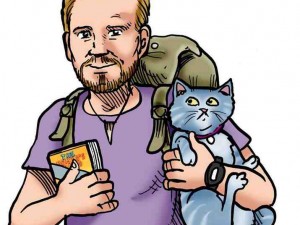 Luke Maguire Armstrong is the author of the intrepid travel collection The Nomad’s Nomad. When he’s not traveling or getting mauled by rodents in the jungle, he spends his time being rejected by girls in bars in Antigua, Guatemala. He broke his left ankle river dancing and his right ankle trying to impress the locals in Belize. Give Luke a guitar; he’ll sing you a song. Hand him a whiskey; he’ll tell you a tale. Give him both, and he’ll give you something to drink about.
Luke Maguire Armstrong is the author of the intrepid travel collection The Nomad’s Nomad. When he’s not traveling or getting mauled by rodents in the jungle, he spends his time being rejected by girls in bars in Antigua, Guatemala. He broke his left ankle river dancing and his right ankle trying to impress the locals in Belize. Give Luke a guitar; he’ll sing you a song. Hand him a whiskey; he’ll tell you a tale. Give him both, and he’ll give you something to drink about.
The post The 5 Ways to Read The Directions to Happiness by Bruce Northam appeared first on The Expeditioner Travel Site.
]]>The post Top 10 Things To Eat In Nicaragua appeared first on The Expeditioner Travel Site.
]]>You hold your beckoning belly and look out into a busy market of street food vendors. You gaze down another cobblestone street in Granada full of restaurants, ready to jump into the local cuisine. Since peanut butter is no longer going to be on the menu for your trip, what can you expect to be filling your plate and gut with this trip?
To get a sense of the unique food here, with its Spanish, Creole and indigenous influences, here are the top ten Nicaraguan dishes for you to eat while in the country.
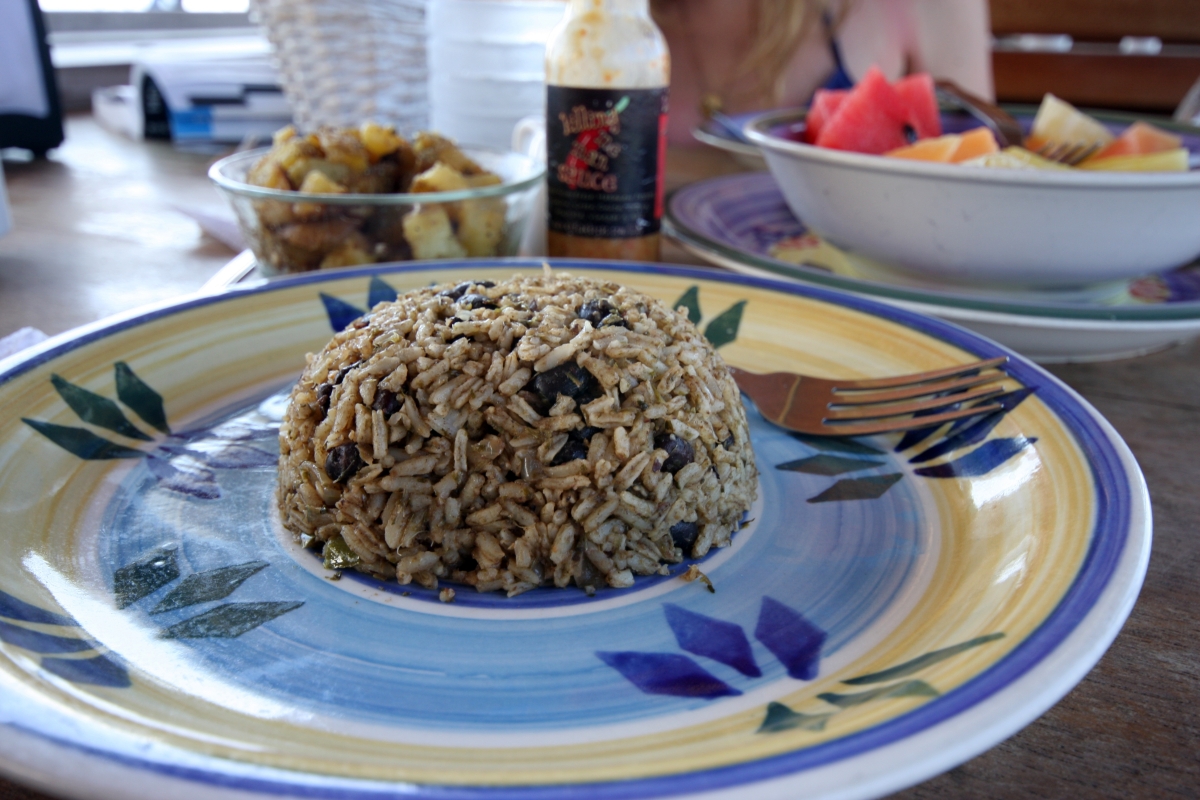
Gallo Pinto
Literally, painted chicken, gallo pinto is the staple food in most Nicaraguan’s diet. Never have grains of rice danced with so much flavor with frijoles.”How could this be,” you ask yourself, thinking, it’s just rice and beans? But Maria, the cook who made them, has a coy, culinary smile on her face, and now you know, Maria is magic, and so are the rice and beans in Nicaragua, tasting in a way no one ever imagined they could. On the Caribbean coast, they mix the rice and beans with coconut. Is it any wonder then why people there walk with a satisfied swagger and often burst out into random song?

Indio Viejo
The tongue is for tasting and storytelling, and indio viejo (old indian) is a dish peppered with legend. As the story goes, a huddle of indigenous Nicaraguans had just prepared a feast of indio viejo when a group of Spanish conquistadors came by and asked them, “Damn, what smells so good?” The Nicaraguans, suspecting that the Spanish had come to mooch off them, told them that an old Indian had just died and that they were serving him up with tortillas, sending the Spanish along their hungry way.
Indio viejo is actually a delicious, heavy meal that takes several hours to prepare. Using a fatty piece of beef as a base, it is made with onion, sweet chili, garlic, salt, tortillas, pig fat, hierbabuena and sour orange — the perfect plate of gluttony, served just before a nap in one of the ubiquitous rocking chairs creaking across the country.

Pebre
For brave travelers not currently reading The Lord of the Flies, pebre is a dish consisting of pig head and other pig parts that the cook happens to have laying around such as liver, ears, tongue, face meat, skin and feet. Throw in some onion, garlic and achiote, mix in some rice into the soup, and you not only have a meal that would satisfy a rogue black bear, but something to tweet home about.

Elotes (Corn on the Cob)
There’s a simple secret to the corn in Nicaragua, which adds a second level of flavorful fantastic. It’s all in the second cooking. The corn is cooked in its husk and then reheated on a grill when it’s ready to serve, which allows it to retain much of its flavor. Expect lime and salt to be added for flavor.
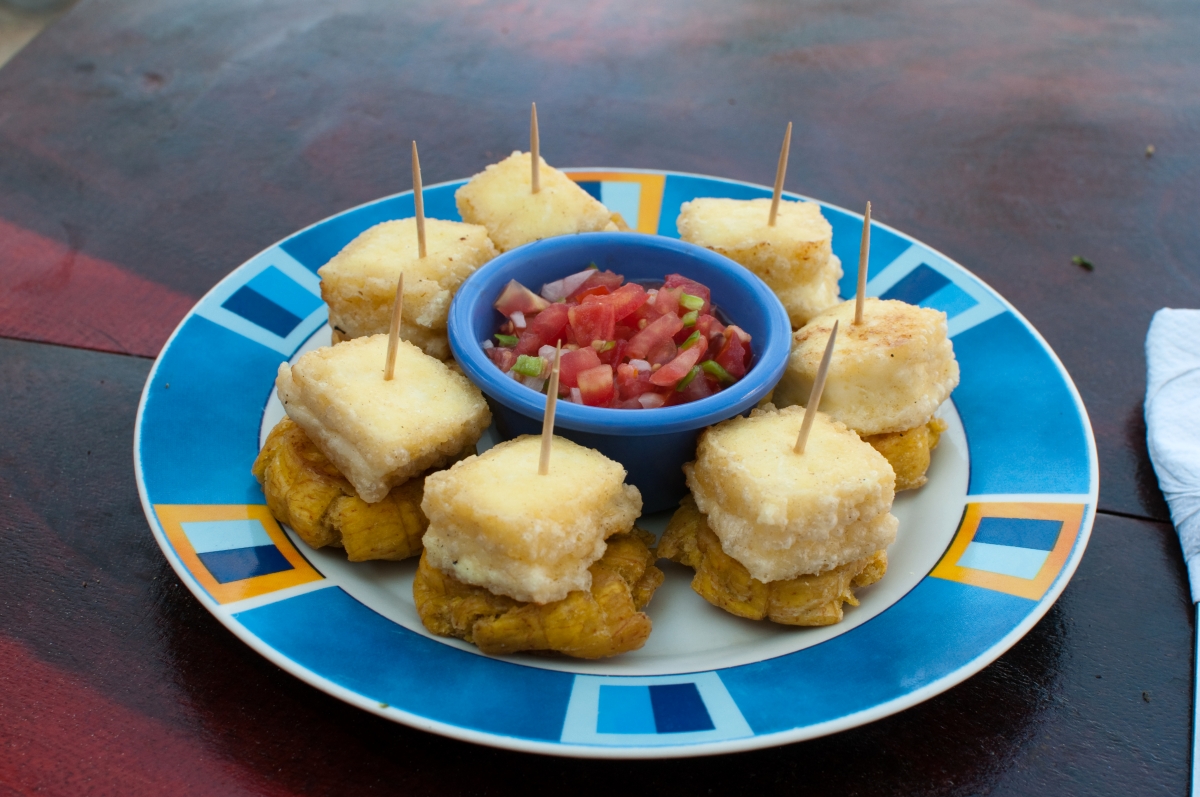
Fried Plantains
Locally called tostones, it is this writer’s opinion that Nicaragua makes them better than anywhere else in the Latin American world. Not mushy like the Guatemalan variety, is it any wonder that the letters from crunchy, jungle-grown tostones can be rearranged to read as “Tootness!”— which is the nonsensical word you exclaim when you try them.
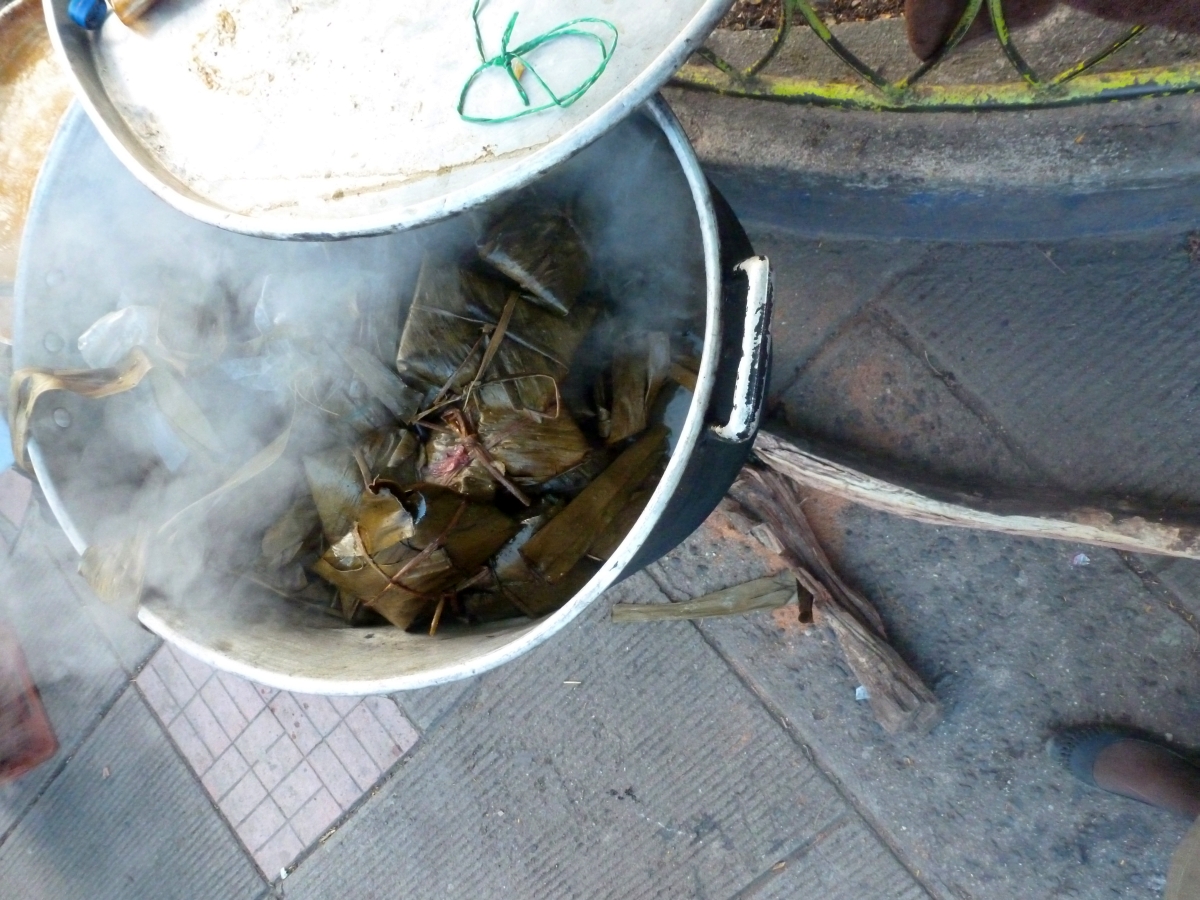
Nacatamal
Along the market roads of Nicaragua, you will inevitably come across a vendor selling little packages wrapped in leaves. Inside these leaves, which are not edible, are meat, rice, potatoes, tomatoes, onions and sweet pepper, all cooked in a dough made of ground corn and butter. Nacatamal is boiled for five hours in the leaves, and can easily be consumed in less than five seconds if you put your mind to it.

Sopa Borracha (Drunken Soup)/Sopa de Rosquillas
Served around the Christmas holidays, the conversation goes like this:
Tomato Soup: Sopa Borracha, me and the chicken noodle think that you have a problem.
Sopa Borracha: Cinnamon! Sugar!
Tomato Soup: You can’t go on like this. Are you soup or alcohol?
Sopa Borracha: I came for Christmas! I am not even soup, silly tomato purée, I’m actually an alcohol-soaked bread. I laugh in the face of soup. I am a special blend of liquor, soaked in porous bread, mixed with coffee for power! My bread includes cinnamon, liquor, sugar and water and I taste like Christmas, and I pity the sober fool consuming anything other than me.
Sopa de Rosquillas (Donut Soup) – Because it is time to think outside of the bowl. Drunken Soup’s best friend since forever, donut soup, is made with corn donuts mushed into a sweet base. It’s great because — do I really need to explain? It’s soup made out of donuts and haven’t we been subconsciously craving this for years?

Tres Leches
Now, it’s time for desert, and travelers to Nicaragua talk about Tres Leches like European backpackers speak about Nutella: in hushed, reverent tones that always end with the entreating question, “Do you have any?” Tres Leches is made with three kinds of milk — straight-up normal milk, condensed milk and cream. After that, throw some sugar, flour eggs and meringue in the mix and you are eating a dish that many a Nicaraguan child has stayed up all night dreaming about.

Pinolillo
Ask a Nicaragua to choose between Pinolillo, a corn flour/cacoa-based beverage, and the person they love the most, and they won’t understand the question because they are the same thing. Nicaraguans love their thick, chocolaty Pinolillo like gringos love Nicaragua. And like gringos, it can easily be found in most market stalls.

[Gallo Pinto by Arvind Grover/Flickr; Pebre by Fermentación Guachaca/Flickr; Elotes via Shutterstock; Fried Plantains by Brian Johnson/Flickr; Tres Leches by Omid Tavallai/Flickr]
 Luke Maguire Armstrong lived in Guatemala directing the humanitarian aid organization, Nuestros Ahijados. His book of poetry, iPoems for the Dolphins to Click Home About, is especially enjoyed by people who “don’t read poetry.”
Luke Maguire Armstrong lived in Guatemala directing the humanitarian aid organization, Nuestros Ahijados. His book of poetry, iPoems for the Dolphins to Click Home About, is especially enjoyed by people who “don’t read poetry.”
The post Top 10 Things To Eat In Nicaragua appeared first on The Expeditioner Travel Site.
]]>The post CNN: America’s Trusted Source For News About Bowel Movements On The High Seas appeared first on The Expeditioner Travel Site.
]]>
I’ve come to a recent conclusion: CNN loves to report on the bathroom activities of people on cruise ships. Specifically, their bowel movements, but sometimes they also report about people’s need to throw up in bathrooms on cruise ships. And like other afflictions detrimental to our society as a whole (crack, heroin, How I Met Your Mother), I can’t get enough of it (okay, minus the crack and the heroin). In fact, a review of my past posts here reveal that this is the third time I have written about this very topic (I couldn’t even come across another topic I wrote about twice let alone three times).
It seems CNN has it out for cruise ships, specifically Royal Caribbean Cruises, although this may be attributed to the fact that Royal Caribbean’s ships tend to be a great home for the norovirus (or as one recent article put it, “Are cruise ships floating petri dishes?”), the notorious virus that often strikes large populations confined to small areas of space (like cruise ships), and which causes nausea, diarrhea, throwing up, and a general need for CNN editors to rush to their keyboards. Granted, I also have it out for cruise ships and think they are the antitheses of travel, but what is the deal with CNN, cruise ships and breaking news about diarrhea aboard them?
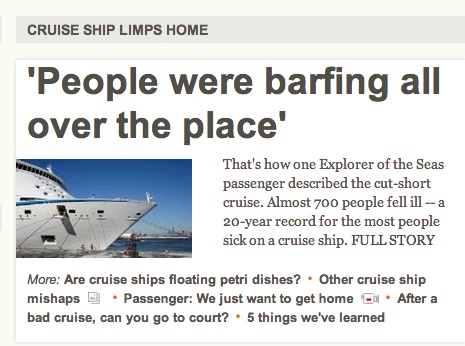
In 2010 I wrote about how CNN had called the toilets on a cruise ship a “Tragedy on the High Seas.” In 2013 I reported on a headline that CNN ran about stopped up toilets on a cruise ship. I could go on, but I plan to have lunch soon.
CNN is again doing what they do best, reporting on crap at sea. Last week, CNN reported on the most recent case of norovirus striking a large cruise ship, Royal Caribbean’s The Majesty of the Seas, which was compelled to return home to port after another norovirus outbreak occurred. While this was surely unpleasant, they ran a headline about this for an entire day. Every day since, they have followed up with reports about the ship.
If any of our readers have insight into why CNN continues to relentlessly report on this, please let your conspiracy theories abound in the comment section. The only theory I can come up with is that CNN journalists take lots of cruises, so they report on what is pressing for them, but irrelevant to most everyone else in the world.
Here are just a seven diarrhea/cruise ship stories that CNN has reported on just this last week. There’s probably more, but after finding seven, I swore quietly to myself and decided that’s enough.
Thank you CNN, for your continued coverage of poop (yes, literally):
• Royal Caribbean cruise ship returns home – with a sickness record
• Norovirus: The most common stomach bug
• Dozens of passengers on Royal Caribbean cruise fall ill, company says
• 300 become ill on cruise ship
• Are cruise ships floating petri dishes?
• CDC: Stomach bug strikes second cruise ship
• Royal Caribbean cruise cut short after more than 600 are sickened

About the Author
 After setting out to hitchhike from Chile to Alaska, Luke Maguire Armstrong stopped in Guatemala where he spent four years directing the social service programs of the charity Nuestros Ahijados. He is the author of iPoems for the Dolphins to Click Home About, which is especially enjoyed by people “who don’t read poetry.” His new book, How We Are Human, was recently released. (Follow Luke on Twitter: @lukespartacus)
After setting out to hitchhike from Chile to Alaska, Luke Maguire Armstrong stopped in Guatemala where he spent four years directing the social service programs of the charity Nuestros Ahijados. He is the author of iPoems for the Dolphins to Click Home About, which is especially enjoyed by people “who don’t read poetry.” His new book, How We Are Human, was recently released. (Follow Luke on Twitter: @lukespartacus)
The post CNN: America’s Trusted Source For News About Bowel Movements On The High Seas appeared first on The Expeditioner Travel Site.
]]>The post Turning The Car Around: One Road To Expatriatism appeared first on The Expeditioner Travel Site.
]]>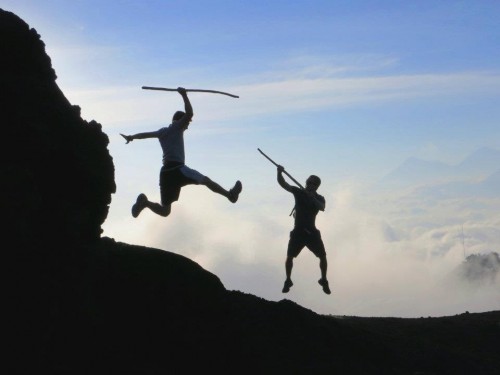
Stories can be told from limitless angles of perspective. So let’s begin this tale from the viewpoint of a Salvadorian family living in a small, rural village. It is a sunshiny day in a one-goat town a few hours drive and world away from the busy capital — a place far removed from the beaches and bars where gringos tend to roam. The day begins no different as previous days, weeks and months. A young couple with a four-year-old son and eight-year-old daughter tend their one-room store across the street from their home. One of their more valuable possessions, a female goat, is tied in front of their store.
Then comes a moment that will lead to a story that their children will retell to their friends at school, mother will recount at family fiestas and the father will tell his soccer buddies, that — sí, no les miento — this really happened. An ’88 Volkswagen Jetta pulls up to the front of their store. Inside are three road-rugged gringos, a puppy and a baby goat.
The gringos get out and begin to chat in shaky Spanish with the family. Pleasantries, smiles and nods are exchanged. Then the gringos huddle and converse amongst themselves in English and come to an agreement. They go to the car, fetch the goat and present it to the now elated family as a gift. This day has taken a unforeseen turn that no previous day, and let’s be real, no subsequent day, is likely to take.
They way stories in the village are swapped and embellished with each telling, we can only guess 10 years from now how the “gringo goat story” will be told: They were gringos — seven feet tall — having just returned from rescuing the goat from a burning barn where every man, woman, child — but not the goat — was killed, so they came to our village and gave us the sole surviving goat.
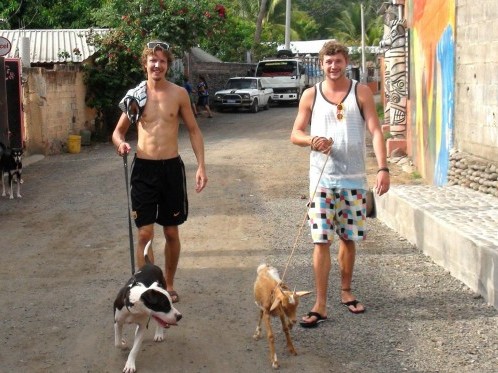
Actually, the goat was a gift for Derek Girard on his 26th birthday. Since he was a kid, Derek had an obsession with goats. To this day, goats are his favorite animal and he loves them with the passion that Miley likes controversially shaking it. He and his younger brother Dustin have had the tradition of one-upping each other on their birthday. Derek will have troubling one-upping the goat (Dustin’s favorite animal is an elephant).
Getting the goat was no easy task. Dustin and friend Dan Pangman spent five hours in the Salvadorian countryside searching for one that was for sale. The process might have been shorter, but prior to El Salvador, the trio had spent time learning Spanish in Mexico, where word for goat, chiva, in Salvador means, cow.
USD$20 and a language lesson later, they had a baby goat, which “shit all over the hostel and ate the garden.” The goat joined the rag-tag trio and took long walks on the beach with them and their 4-month-old puppy in the surf town of El Tunco, El Salvador, before reluctantly, and with heavy hearts, they realized that the goat needed a family; one with a mother and father whose M.O. didn’t consist of smuggling the goat — who couldn’t stand to be away from the trio — into hostels.
Let’s Back Up a Bit Further In the Story
Dan and Derek met when they were both hired by marketing firm JTI, a company which throws massive parties. Part of their “research” consisted of being flown to Toronto to party in exclusive VIP areas of bars and club. Their research paid off. The party they threw in Vancouver was voted the best party in Canada, which netted them a free trip to Miami (is anyone jealous yet?), where they were ushered into a Miami Dolphins games, and onto exclusive yachts for more, yes, partying.
It turned out the pair had more in common than knowing how to throw a killer party: both had spent three months volunteering in Tanzania, an experience that had stayed with them. Though they were having the kind of fun we must imagine two guys in their twenties must have been having working to throw parties, there was a tug towards something they considered bigger.
Our lives tend to plateau into daily routines, and one chance meeting, one conversation, or one decision is all it takes to shake things up and change everything. A conversation that decided their fate and set out a new course went something like this:
“I want to get out of here, quiet my job and travel,” Dan told Derek.
“Bullshit, you are,” Derek told Dan.
“Yes, I am.”
“If you are, then I’m going to do it too.”
“No, you’re not?”
The challenge was on the table and they both egged each other on enough to meet it. They put in their one month’s notice and soon they were jobless and sitting next to each other in a 1988 Jetta, with a vague plan to make it through South America. “It’s a beauty car,” Derek says with a look reserved for talking about beautiful women. “We’ve done so much off-roading in that bitch.”
Along their way they met Derek’s brother Dustin in Antigua, Guatemala, where they planned to only stay a few weeks. Derek says that it was not difficult to convince his brother to leave his North American routine life behind and join in on the adventure. After staying longer than they planned, they finally left Antigua and headed to Guatemala’s Caribbean coast where they spent three months volunteering in Rio Dulce. Derek describes it as a place where, “a cut becomes an infection in a second and you fall apart pretty quick.”
So again, they came back to Antigua to recharge their batteries, planned to stay a couple weeks but stayed a couple months before they were back on the road. They made it as far as Panama. There they were supposed to ferry their car across the canal and continue their travels on a fresh continent, but they felt a tug of having left something behind.
“Antigua had our heart,” Dan says, “We needed to go back.”
As expats in Antigua know, that’s the story of how many a two-week tripper turned into an Antigua Expatriate. Of the countless places they stopped off across the thousands of miles of their journey, it was Antigua, that magical “fairy-tale city” in the highlands, that felt like home.
In their previous stays, they had helped friends, Carlos and Carolina, throw a successful party at their corner bar Porque No, and after juggling around dozens of ideas about what they would do, they decided to “stick with what [they] knew” and open a hip-hop bar. Their goal had been from the beginning to use their talents to give back, to volunteer their time and support efforts, and they saw their vision for their bar as supporting that.
“You have to support your life at some point,” Dan says, “We’re passionate about travel and volunteering and giving back, and this is a way to do that on an ongoing basis.” Dustin and Derek are on the same page. “Our trips were about the pay-it-forward model, giving people good vibes. The law of attraction says that when you give out positive vibes, positive vibes come back to you.”
But this is easier decided than done. In Antigua this is an uphill battle for three gringos needing to get through a pile of paperwork and licensing. Most people “in the know” around Antigua would have told three gringos barely speaking the language a sarcastic “Good luck.” But perseverance and good vibes are a powerful combination, one that can beat most odds, and after eight months of tireless work, and struggle against what some thought a pipe dream, they found themselves serving up opening night drinks.

La Vibras Opens For Business
It’s opening night at La Vibras (Spanish for Vibes) and the house is full. The crowd is a dense concentration of Antigua’s heavy-hitting expatriates who have come to show their support for Derek, Dan and Dustin’s endeavor. That presence means a lot. It means they’ve carved deep inroads into the community. Upon my return to Antigua the month before, it was nearly impossible not to meet Derek, Dan and Dustin, as it seemed most everyone in town not only knew them, but also had nothing but good things to say about them.
I am walking around with a digital recorder interviewing people who are all ecstatic to be here. In the very least, everyone is excited about the free drinks from 6-8 p.m. This means by 8 p.m. I am drunk, and in good, bacchanalian company. Listening to my interviews as I write this, they crescendo with my level of imbibing. Unnecessarily aggressive interviewing fueled by joyous inebriation and rude interruptions and rambling questioning, I decide is the appropriate term for my voice I am listening to.
Everything I record after 9 p.m. is painful for me to hear, but I type out the important stuff and then delete the recordings for fear that these could fall into the wrong blackmailing hands — my interview with Derek sounds more like harassment than reporting. Upon his saying, “I believe everything happens for a reason,” I hear my voice respond, “What do you mean? Does everything happen for a reason, because some people die sad and alone?”
WTF, Luke? But the vibe of Las Vibras is one where everyone is enjoying themselves to the max. Antigua, and other such dots on the expatriate map, is a place where a vision like this can materialize when a person commits to their casual daydreaming. The consensus seems universal: Derek, Dan and Dustin are refreshing to have here, opening a kind of bar that the community was lacking: “Where sleek meets the street,” as Derek puts it.
The night began with Dan playing music, both covers and original, on his acoustic guitar, and then led to upbeat hip-hop and pop music. People are drinking, dancing and admiring the graffiti art covering every wall. Alex, a British expat in Antigua, spent three months perfecting and finishing the wall art. He painted the exit signs the day before opening night.
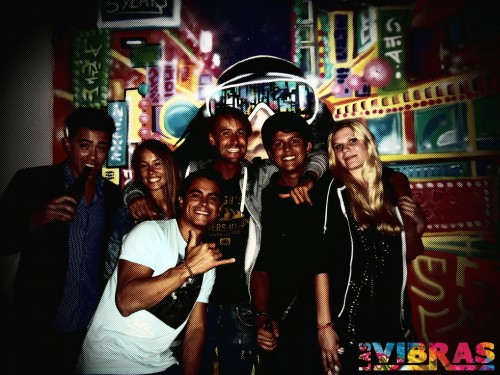
When you follow the line of cause and effect long enough, you see that all of this — the swaying revelers, the art, the music, everyone in this room — is the result of a conversation that led to a dare, which led to not backing away from a risk. Dan put it perfectly: “A risk like quitting your job, going traveling, following your dreams — it’s riskier not to take it. You can always revert back to your mainstream lifestyle, but you can’t go and live out that dream when you let it pass by.”
Derek, basking in the glow of a successful opening night thinks back to the eight months it took them to get to this point. “It’s all about positivity. Every time you get a no, it’s just a challenge. They can say no to us all we want, but we are going to continue going. They say, no no no no, and we say yes yes yes yes.”
“My life in Canada was not based on happiness,” Derek continues, “it was based on all the wrong reasons. The pressure that they put upon you in society to be successful, graduate from high school, then get a degree and a job and start working. I am going to live life for happiness. If I’m happy, I can make other people happy, and if I’m miserable, I can’t.”
No one here tonight seems miserable. There’s a special vibe in the air, and the buzz of “the new place” has yielded to a night when La Vibras opened its doors and invited the world at large to come on in and throw back a round.
On my recorder, I skip through several hours of irrelevant interviewing I conducted near the bar. It seems by 11 p.m. that I am using my microphone exclusively to try to talk to girls; only occasionally remembering to ask them about the bar. “I’m stoked,” a Peace Corps volunteer says over the sounds of music and people enjoying themselves, “tons of people, great vibes, music is good, this is great.”
And just as a goat in El Salvador found an improbable home in the countryside, it seems that Derek, Dustin and Dan have found theirs in Antigua.

About the Author
 After setting out to hitchhike from Chile to Alaska, Luke Maguire Armstrong stopped in Guatemala where he spent four years directing the social service programs of the charity Nuestros Ahijados. He is the author of iPoems for the Dolphins to Click Home About, which is especially enjoyed by people “who don’t read poetry.” His new book, How We Are Human, was recently released. (Follow Luke on Twitter: @lukespartacus)
After setting out to hitchhike from Chile to Alaska, Luke Maguire Armstrong stopped in Guatemala where he spent four years directing the social service programs of the charity Nuestros Ahijados. He is the author of iPoems for the Dolphins to Click Home About, which is especially enjoyed by people “who don’t read poetry.” His new book, How We Are Human, was recently released. (Follow Luke on Twitter: @lukespartacus)
The post Turning The Car Around: One Road To Expatriatism appeared first on The Expeditioner Travel Site.
]]>The post Open Call For Submissions: Poetry Written By Travelers appeared first on The Expeditioner Travel Site.
]]>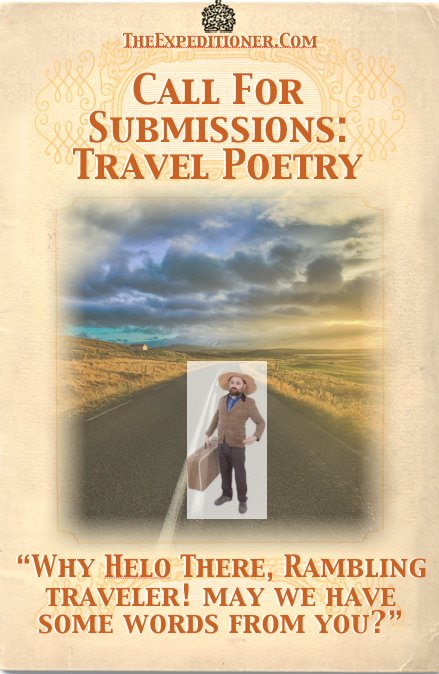
There are a number of books of travel poetry out there. Here we see a copy of Song of The Open Road: Poems of Travel & Adventure grazing with her offspring with a herd of bison who’ve taken to the open prairie where man, book and buffalo can still be free.
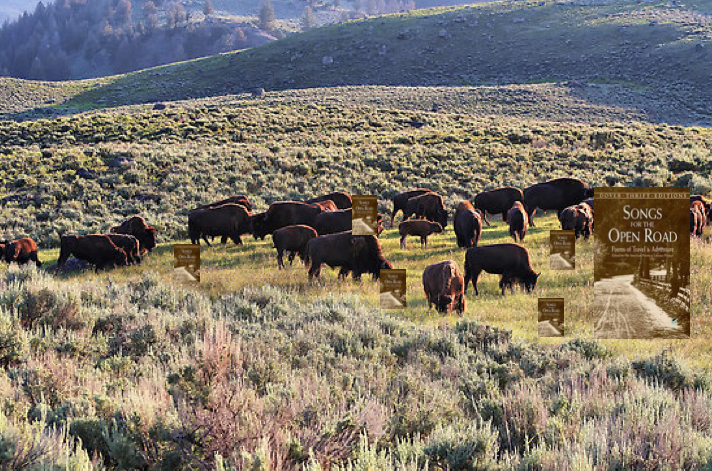
While the Expeditioner loves these books, (we have one in every bathroom magazine rack at The Expeditioner’s headquarters), these are not the kind of poems we are looking for.
This book is great, but it’s poetry about travel. The Expeditioner is looking for poetry written by travelers. We think there is an important distinction, and to prove it, we are going to be publishing in paperback, Voyaging Verse: A Collection, in the Fall of 2013.
Based on extensive Google searches conducted in between bites of my sandwich, I have concluded that no such book exists.
This is not just a call for submission — despite this post’s title — it’s really a call to action. We’re biased of course, but we believe that travelling is not just about seeing things, but discovering something inside of ourselves. People who spend their time seeing the world have a lot of insight to offer and we can think of no more beautiful way to convey this than through poetry.
Poetry, like travel, is another sort of search for meaning. Submissions are open through July. Please submit 2-5 poems of any length to Luke [at] TheExpeditoner [dot] com for consideration.
Please help us put together the highest quality book of voyaging verses we can by spreading the world to your other rambling amigos. Below is a flyer that can be printed out and placed in locales sure to be frequented by travelers (hostels, large sailing vessels, airports, the back of Rolf Potts’ shirt).


About the Author
 After setting out to hitchhike from Chile to Alaska, Luke Maguire Armstrong stopped in Guatemala where he spent four years directing the social service programs of the charity Nuestros Ahijados. He is the author of iPoems for the Dolphins to Click Home About, which is especially enjoyed by people “who don’t read poetry.” His new book, How We Are Human, was recently released. (Follow Luke on Twitter: @lukespartacus)
After setting out to hitchhike from Chile to Alaska, Luke Maguire Armstrong stopped in Guatemala where he spent four years directing the social service programs of the charity Nuestros Ahijados. He is the author of iPoems for the Dolphins to Click Home About, which is especially enjoyed by people “who don’t read poetry.” His new book, How We Are Human, was recently released. (Follow Luke on Twitter: @lukespartacus)
The post Open Call For Submissions: Poetry Written By Travelers appeared first on The Expeditioner Travel Site.
]]>The post Why Is CNN Obsessed With Cruise Ship Toilets? appeared first on The Expeditioner Travel Site.
]]>
Go ahead, ask me how I feel about cruise ships. I feel fine about them. Feel free, ask me to elaborate. See, they really are not my thing, but whatever, if people like taking a cruise, I say go for it. To each their own. Ask me what I really think. Fine, because you pressed me with this relentless barrage of unnecessary questions, I will tell you that I think cruise ships is to traveling what Twinkies (they’re coming back) wrapped in Kraft cheese singles is to haute cuisine.
Frankly, there seems little reason for a cruise ship to pull out of the port, since most of the “trip” will be spent “onboard” and the “visit” to other cultures is as immersive as taking swimming lessons in a bathtub.
I wrote a piece in 2010 here at TheExpeditioner about Cruise ships in an article titled “Tragedy On The High Seas Makes CNN and Carnival Look Like Extreme Sissies.” Essentially, CNN covered an incident in which a cruise ship lost power for a couple days like they were covering a war zone — calling broken showers and the lack of air conditioning an “ordeal” and “tragedy.”
Well friends and foes, CNN and another cruise ship with problems has turned up on the headline page of CNN’s travel section. This time a “Cruise ship suffer[ed] stopped-up toilets.”
Bravo again CNN, you are cutting edge in cruise ship bathroom journalism.

From CNN correspondent Katia Hetter’s brave cruise ship bathroom coverage, “On April 11, the cruise line’s Crown Princess was on a seven-day Caribbean cruise when a blockage within the ship’s vacuum toilet system rendered 410 stateroom toilets inoperable from 5 a.m. to 6:30 p.m.”
But it was not a complete tragedy, as affected passengers were given $50 each. This makes my own stunt of drinking a gallon of water on a bus in high school during a speech trip and not using the bathroom for four hours for $10 seem underpaid. But then again, I was doing it to impress girls, who, seemed unenthused with my talents. C’est la vie
Apparently, though, as CNN quoted Astro Flyer in their coverage, these things happen. “Toilet problems can happen on any ship when passengers flush the wrong things down.” He’s speaking the truth. You can’t just flush anything down the toilets, as another high school experience with a lobster taught me over the course of before-school detention when I was tasked with the job of helping the janitor clean the gyms to give me time to reflect on what exactly had compelled me to put a live lobster in the toilet. Once again, it was girls.
There might be something I am missing here. CNN is either way too concerned with cruise ship feces, or they are super meta-genius journalist hipsters delving into the mythical fifth realm of irony and this is all an elaborate joke that only people with very thick-rimmed glasses are snickering about. I’m going to have to think about this a little more — perhaps while in the bathroom.

About the Author
 After setting out to hitchhike from Chile to Alaska, Luke Maguire Armstrong stopped in Guatemala where he spent four years directing the social service programs of the charity Nuestros Ahijados. He is the author of, iPoems for the Dolphins to Click Home About (available for sale on Amazon.com) which is especially enjoyed by people “who don’t read poetry.” (Follow Luke on Twitter: @lukespartacus). His new book, How We Are Human, was recently released.
After setting out to hitchhike from Chile to Alaska, Luke Maguire Armstrong stopped in Guatemala where he spent four years directing the social service programs of the charity Nuestros Ahijados. He is the author of, iPoems for the Dolphins to Click Home About (available for sale on Amazon.com) which is especially enjoyed by people “who don’t read poetry.” (Follow Luke on Twitter: @lukespartacus). His new book, How We Are Human, was recently released.
The post Why Is CNN Obsessed With Cruise Ship Toilets? appeared first on The Expeditioner Travel Site.
]]>The post Luke In Kenya Part 5: Elephants, Elephants, Elephants: Kenya! appeared first on The Expeditioner Travel Site.
]]>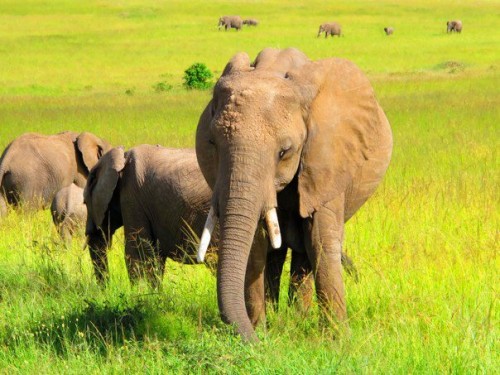
The big elephant in the room is that there is no elephant at all. I’ve been in East Africa for two months and in none of my writings have I so much as broached the subject. Matt Stabile claims he’s not mad about this lapse, just disappointed. He has good reason: I am under contract to write about elephants.
Matt and my favorite drinking game is called, “Luke, sign this stack of contracts.” Matt came up with it. Here’s how it works: you take a bunch of whiskey shots with Matt Stabile, and then he hands you a stack of contracts and you sign them and he notarizes them with his power of attorney. Sounds fun, right? Yeah, it’s a blast until you wake up one morning and Matt is wheeling your grandmother out of the nursing home claiming he owns her.
Anyways, hold onto your contraband ivory letter openers The Expeditioner readers, because my elephant silence is officially over!
Nairobbery National Park
The first time I was promised elephants was when my brothers and I traveled to Nairobi National Park. Located inside Kenya’s capital, with distant views of the city’s skyline, this makes it one of the most unique game parks on Earth.
Further separating it from its countryside counterparts is the fact that it doesn’t seem to have any animals in it. It is home to grass. And trees. My brother has taken to calling it Nairobbery National Park due to the fact that we paid a handsome sum to be there for four hours of continuous letdown. After driving 100 or so kilometers through the park, we saw a total of three animals: two ostriches and a tortoise moving at the pace of our excitement.
“We should have brought beer,” my brother said as we admired another empty field of grass and trees.
Elephant Beer, Greatest Beer on Earth
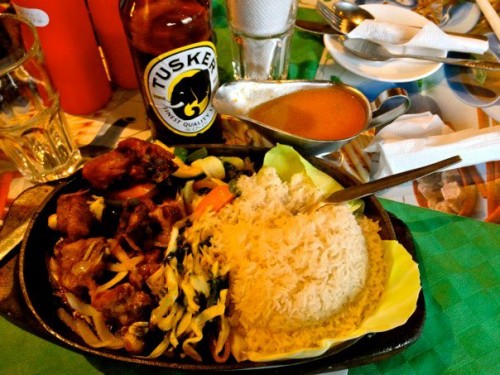
Tusker Beer — as national beers always tend to be — is the pride of Kenya. It’s also my favorite beer. Not because it tastes better than my second favorite beer, Baltica 6, but because I am a guy who appreciates a good backstory. Tusker beer is named after the elephant who killed the founder of the brewery that makes it. Also, Hemingway use to drink it like I used to devour him as a Busch Lite-swilling undergraduate beer pong champion.
Maasai Mara National Park
My next chance to see an elephant came when my brothers and I went to Masai Mara National Park on safari.
The Grand Canyon is where you go to marvel at geology. Niagara Falls is visited for by-the-book honeymooners after a boring wedding ceremony. Guatemala City is where you go to get mugged.
Maasai Mara National Park is where you go to have that clichéd, but still great, proverbial moment of paused reflection that catches a glimpse of our humanity before we broke out of the Circle of Life to check our email and update our Facebook statuses.
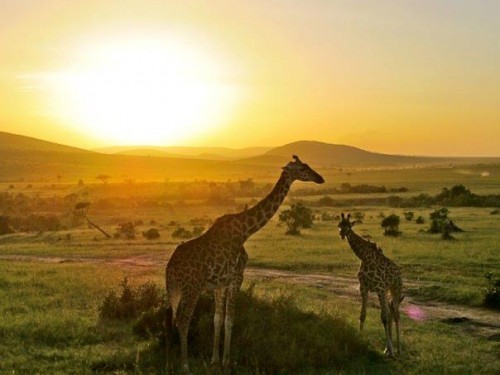
Most of the animals are friends you realize as you watch giraffes giving a nod to a herd of elephants — which are smaller than you would think they would be, but still damned majestic — and where gazelles and water buffalo hang out like barnyard pals, while wildebeests, looking insecure with with their ridiculous manes, stare longingly at hippos, wondering why the crocodiles are not interested. And then there are humans, roving around in Jeeps, capturing photos for . . . what? Facebook? Posterity?
Anthropologists change their mind a lot, but they mostly agree that at one point in our history, this was our past stomping ground too. Maybe the giraffes used to let our kids hang out with theirs.
In this line of thought, an African safari is less about discovering and more about remembering. It’s a nod to our essence, a visit to our specie’s alma mater — nostalgically rewarding — a thought as unbounded as our capacity to explore it.
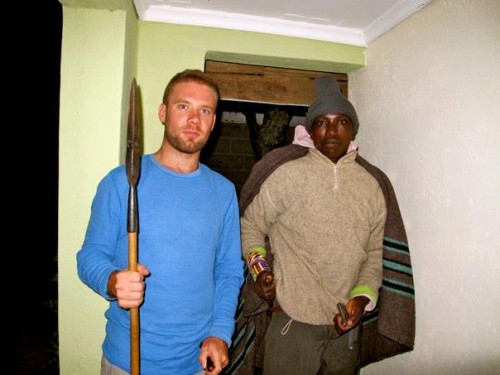
A Maasai warrior who let me hold his spear confirmed the adage that an elephant never forgets. If a person has ever upset an elephant, decades later, the animal will become unnerved at seeing that person again. An elephant also does not forgive.
I think that’s fair, even a bit human of the elephant. Unlike squirrels, who are racists and lump all seven billion of us into one category, elephants give everyone the chance to prove or disprove his/herself on an individual basis.
• Read the entire “Luke in Kenya” series here.

About the Author
 After setting out to hitchhike from Chile to Alaska, Luke Maguire Armstrong stopped in Guatemala where he spent four years directing the social service programs of the charity Nuestros Ahijados. He is the author of, iPoems for the Dolphins to Click Home About (available for sale on Amazon.com) which is especially enjoyed by people “who don’t read poetry.” (Follow Luke on Twitter: @lukespartacus). His new book, How We Are Human, was recently released.
After setting out to hitchhike from Chile to Alaska, Luke Maguire Armstrong stopped in Guatemala where he spent four years directing the social service programs of the charity Nuestros Ahijados. He is the author of, iPoems for the Dolphins to Click Home About (available for sale on Amazon.com) which is especially enjoyed by people “who don’t read poetry.” (Follow Luke on Twitter: @lukespartacus). His new book, How We Are Human, was recently released.
The post Luke In Kenya Part 5: Elephants, Elephants, Elephants: Kenya! appeared first on The Expeditioner Travel Site.
]]>The post Luke In Kenya Part 4: A Promise Stretching Through Time In Kenya appeared first on The Expeditioner Travel Site.
]]>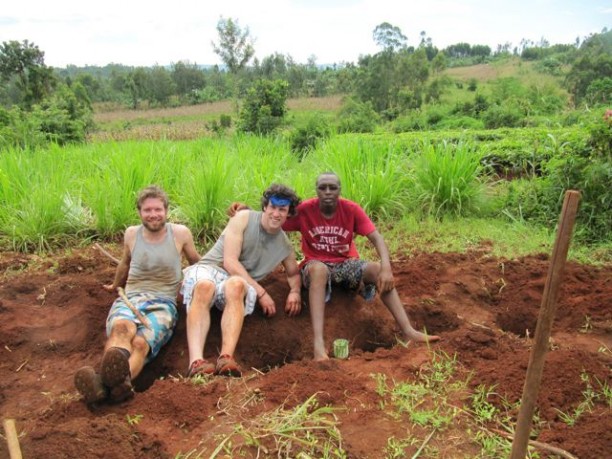
Luke in Kenya: Part 4
“Luke in Kenya” is a travel series from Managing Editor Luke Armstrong as he travels to Kenya to visit the homeland of his adopted brother.
We wake up early on the first day of construction to a brief breakfast of fry bread and coffee just as the sun throws hints of its rise on the horizon. No winter comes here in Kisii, Kenya, and in every direction are miles of green hills kept lush by frequent rains.
On the way to the building site, Calvin points to a row of trees reaching 50 feet into the air. “I planted those,” he says, “just before I came to the U.S.”
These are the physical markers of passing time. Other markers, less physically dramatic, paint a fuller picture of his story. These include Calvin and Joash’s diploma from Saint Mary’s Central High School; Calvin’s four-year college degree from The University of Mary; Joash’s NCAA track and cross country trophies and countless other markers stretching a decade into the past.
Our presence here today on a building site and Calvin’s return are other markers that tell his story.
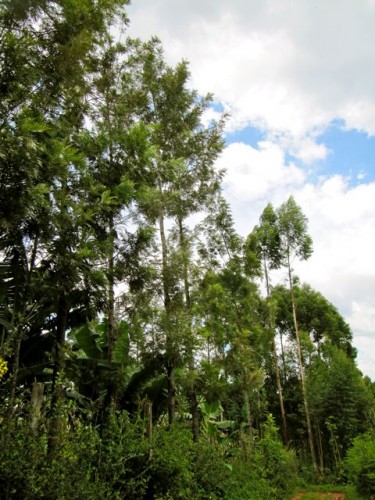
Against the Odds
When I was in high school my parents took in Calvin and then his brother Joash, two orphans from Kenya. My parents were not seeking to adopt, but were not opposed to it when Evan Beauchamp, the missionary leading the Bismarck Diocesan Mission, asked them if they would.
After reading a book that planted the seed of a dream in Calvin, he’d spent the last year petitioning Evan to take him to the United States, where he wanted to study to become a doctor — a pipe dream for an orphan in a poor village in rural Kenya.
Initially, Evan told Calvin this was not possible. But if Calvin can be characterized as anything, it is persistent. After a year of pleading, Evan relented and said he’d see what he could do. He knocked on a lot of doors that didn’t open. Finally, he thought of my family, his thinking being, well the Armstrongs already have eight kids, what’s one more?
A New Home in Kenya
It wasn’t our original impetus for coming to Kenya, but after we read an e-mail from Calvin, it became our raison d’être to make the trip. Calvin had just finished medical school in the Caribbean and was back in Kenya to get a visa for his clinical rotations in the U.S. While back in his native village, he met two AIDS orphans, Samuel (15) and Simon (13), a half-kilometer from where he and his brothers had been orphaned by the same cause.
These two brothers were being looked after by their grandparents who gave them all they could, which amounted to a place to sleep and a meal a day, but not enough not keep them in school.
Calvin sent an e-mail to rally the troops. Everyone in our family got on the fundraising horn: my dad on the radio, my mom writing, me blogging; even my brother John, who is Simon’s age, helped by donating some of his Christmas money for the boys to buy books. Enough was directed to the Diocesan Mission to build the orphans a house and put them in a good school. My brother, Tyler, and I left for Kenya to meet Calvin, packing our work boots, ready to assist in the construction in a home for Samuel and Simon.

Samuel and Simon
We met Samuel and Simon the evening after the first day of construction. “My father is buried here,” Samuel informed us, pointing to a vegetable garden where beans had just sprouted. A few yards away he pointed to a patch of Napier grass, the kind they feed to cows. “My mother is buried there.”
He signaled to the graves without emotion, despite the fact that he was discussing the final resting place of both his parents. His father died in 2005; his mother in 2010. Both were victims of AIDS.
Tyler, Calvin and I followed the two boys down a narrow, muddy trail to their grandparent’s house. Their grandfather is a graying man who supports himself with a cane. Their grandmother is a trembling woman with a strained gait. Both carry solemn expressions and seem to know that they won’t be around much longer to look after their parentless grandchildren.
We arrived at their grandparents’ home just as the sun was setting and were seated around a battered table in their mud hut. The cicadas began their song, one that would grow in volume as the darkness increased.
When night fell fully, we were left in darkness. There were no streetlights outside and no artificial illuminations — complete and utter darkness broken only by our voices and the cicada’s song.
“You see,” Calvin said, “they don’t have a way to do their homework after dark. They can’t even afford candles.”
Calvin turned to me to indicate I begin the meeting. It was as solemn as an occasion as I’d ever attended. On both sides of the table, promises whose obligations would extend for years were made.
With Calvin translating, I explained to the two boys that Calvin’s parents had also died of AIDS. “Joash and Calvin,” I said, “are my brothers who grew up in this village. Now, Joash is studying to be a nurse and Calvin a doctor.”
“What do you want to be when you grow up?” I asked them. Samuel, the oldest, said he wanted to be a doctor. Simon said he wanted to be a pilot. Life’s deck is stacked considerably against either profession, but the same could have been said of Calvin and Joash’s plans a decade ago.
“My brothers and I are going to make a promise to you,” I told them. “We promise to make sure you have enough money to stay in school — the best school here — if you promise to stay in school, work hard and get good grades.”
“You have to get the best grades,” Calvin interjected, “number one and number one.”
In the darkness, both boys nodded and promised this. They shook my hand, then Calvin’s and finally Tyler’s. Their grandfather rose slowly from his chair and they shook his hand.
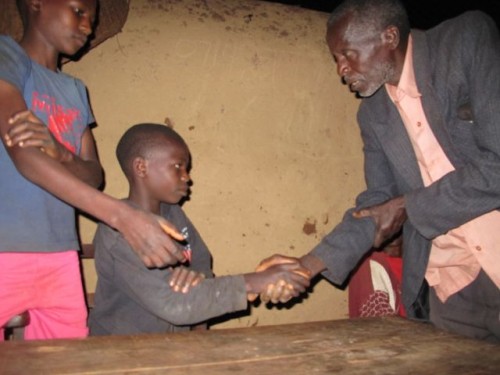
These were not the whimsical bargains of children, but the solemn promises of men who understood what their vow entailed.
Our agreement on both sides made, the boys told us what they remembered about their parents. In African culture, the dead and the living walk together. Those living carry the spirit of those who have passed on.
Both boys remember what their mother told them before she died. “I am sick,” she told them, “but you are well. If you walk humbly, stay away from bad influences and get an education, you will be okay.”
Then the boy’s uncle told Calvin a story about his mother that he’d never heard. After their father died, Calvin and Joash sometimes stayed with relatives and their mother would have to stay home alone. She was afraid of the dark — as many here are — worried of witches and other dangers, real and imagined, that lurk in the African night. Someone from Simon and Samuel’s family used to come and stay with her so that she would not be afraid.
Calvin smiled and let out a hearty chuckle. “I never knew that. Wow.” For an orphan, any new story about a parent is grasped for and held dear.
Today, we don’t know how Samuel and Simon’s story ends. But we know that now they have a home and enough support to attend school. We believe they are serious in their promise to work hard towards a life free of the disparaging poverty common in this region. We hold the hope that 10 years from now, when trees planted today tower 50 feet above the earth, Simon and Samuel will be where they dream to be.
• Read the entire “Luke in Kenya” series here.

About the Author
 After setting out to hitchhike from Chile to Alaska, Luke Maguire Armstrong stopped in Guatemala where he spent four years directing the social service programs of the charity Nuestros Ahijados. He is the author of, iPoems for the Dolphins to Click Home About (available for sale on Amazon.com) which is especially enjoyed by people “who don’t read poetry.” (Follow Luke on Twitter: @lukespartacus). His new book, How We Are Human, was recently released.
After setting out to hitchhike from Chile to Alaska, Luke Maguire Armstrong stopped in Guatemala where he spent four years directing the social service programs of the charity Nuestros Ahijados. He is the author of, iPoems for the Dolphins to Click Home About (available for sale on Amazon.com) which is especially enjoyed by people “who don’t read poetry.” (Follow Luke on Twitter: @lukespartacus). His new book, How We Are Human, was recently released.
The post Luke In Kenya Part 4: A Promise Stretching Through Time In Kenya appeared first on The Expeditioner Travel Site.
]]>The post Luke In Kenya Part 3: The Happiest Man in Mombasa appeared first on The Expeditioner Travel Site.
]]>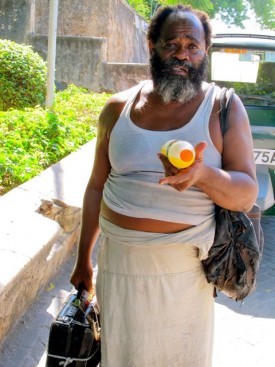
Luke in Kenya: Part 3
“Luke in Kenya” is a travel series from Managing Editor Luke Armstrong as he travels to Kenya to visit the homeland of his adopted brother.
He’s always going, but never arrives.
They call him “The Traveler.” He’s a familiar face along the sunny streets of Old Mombasa. His unique blend of exotic joy fits in the postcard-environment of the city. In his right hand he carries an old leather briefcase filled with books — bursting at the seams and intact only due to twine tied around its frame. Dangling from his left shoulder is an ancient green backpack. His dress is a tunic made from recycled canvas. A faded return address can just be made on out from a time when the fabric protected (presumably) a crate being shipped from a far-off destination.
I passed him without noticing when my group of haphazardly assembled travelers left Fort Jesus to find a restaurant. Michelle, a woman from South Sudan, pointed him out and told me the handful of details she’d gleaned during her two-week stay in Mombasa.
“They call him The Traveler,” she told me — one of my trigger words.
“I’ll catch up with you later,” I said to the group, finding nothing more appealing at that moment then finding myself in a conversation with him.
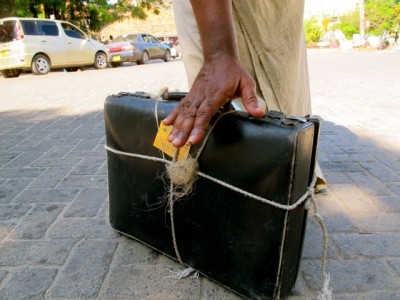
When I reached the intersection where he had disappeared, I asked a woman selling soft drinks which way The Traveler had gone.
“That way,” she pointed, knowing whom I meant.
When I approached him, he shook my hand and pointed to my camera and them himself. I asked if I could record him. “Sure, sure, yes,” he said, nodding.
Much of what he said didn’t make sense. “And the waters cold in the villages . . . I can’t, I can’t, I can’t do that. You can go while it is, it’s okay, it’s alright . . . bring me what is, you can read the lesson.” But his voice had a certain melody to it as it switched from one language to gibberish to another. Like a good song heard for the first time, when it stopped I wanted to hear it again and again. The vendors around said the same thing about him, “He’s a happy, happy man.”
I’ll vouch for that. He’s maybe one of the happiest.
“He has no home,” another vendor told me.
“He’s a very educated man,” said a third, “but one day he just went . . . ” the man circumscribed the circumference of his ear, pantomiming the universal sign for loony.
A police officer on the beat told me he never had any trouble with The Traveler, who he called “Bob.” He also said that Bob was always happy.
The vender who told me he was well educated told me to go to a café named Yahazi’s and ask him to tell me a story about him. I didn’t end up making it there and will have to save it for the if and when I return to Mombasa. One never knows which road will lead you back to where you started.
I realize this isn’t much, and this may all I never know about The Traveler: one tiny glimpse. But I’m glad he’s out there, a traveler caught in a loop, never leaving but always going, and blissfully content with that. There are metaphors in that, but I’ll leave you the reader to fill in your own.
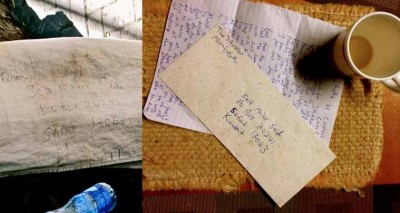
This story does not end completely here. I have no idea how long ago that return address was written on what is now The Traveler’s tunic. Maybe that P. O. Box in Kuwait City is still in existence — maybe not. Maybe it’s being used by the same person — maybe another. Whatever the case, I’ve addressed an envelope to it. Inside I’ve printed one of my favorite travel poems, “Ithaka” by Constantine Cavafly. Though The Traveler may never end up making it to the airport, he’s still at least inspired this letter to be sent to the Kuwait address. I’ll send it via airmail.
• Read the entire “Luke in Kenya” series here.

About the Author
 After setting out to hitchhike from Chile to Alaska, Luke Maguire Armstrong stopped in Guatemala where he spent four years directing the social service programs of the charity Nuestros Ahijados. He is the author of, iPoems for the Dolphins to Click Home About (available for sale on Amazon.com) which is especially enjoyed by people “who don’t read poetry.” (Follow Luke on Twitter: @lukespartacus). His new book, How We Are Human, was recently released.
After setting out to hitchhike from Chile to Alaska, Luke Maguire Armstrong stopped in Guatemala where he spent four years directing the social service programs of the charity Nuestros Ahijados. He is the author of, iPoems for the Dolphins to Click Home About (available for sale on Amazon.com) which is especially enjoyed by people “who don’t read poetry.” (Follow Luke on Twitter: @lukespartacus). His new book, How We Are Human, was recently released.
The post Luke In Kenya Part 3: The Happiest Man in Mombasa appeared first on The Expeditioner Travel Site.
]]>The post Luke In Kenya Part 2: Nairobi’s Kibera Slum [Photo Essay] appeared first on The Expeditioner Travel Site.
]]>
Luke in Kenya: Part 2
“Luke in Kenya” is a travel series from Managing Editor Luke Armstrong as he travels to Kenya to visit the homeland of his adopted brother.
Nairobi’s Kibera slum is Africa’s second largest. Most families subsist on less than $1 a day. Though present (and often highlighted by the media and NGOs), desperation is not the rule here. By our Western standards, Kibera is a place with atrocious living conditions. But most here are there by choice, escaping hungry conditions in the countryside to find opportunities and work. It reminds me of the 1860’s New York as portrayed in Gangs of New York. In Kibera you find excitement; hustle and bustle. As the Economist aptly pointed out, “Kibera may be the most entrepreneurial place on the planet.”
Kibera is by no means an easy place to live. To fill your belly, every day requires hard work and ingenuity.

Kibera’s populations swells and contracts from 600, 000 to 1.5 million. They often shrink during elections years (March 4, 2013, is the next one) when tensions between the 42 different tribes cause people to get out of Dodge.
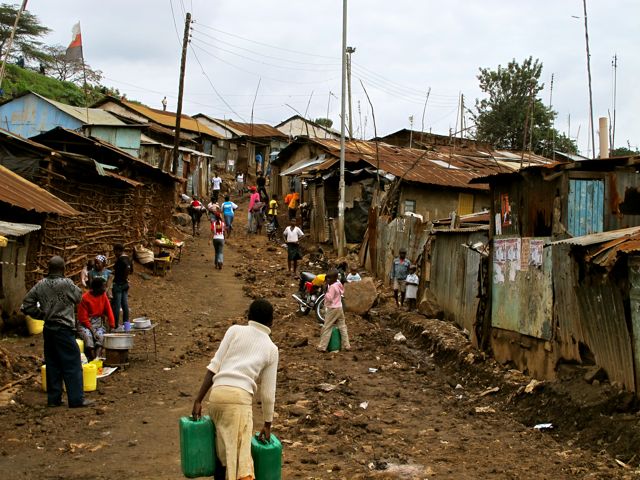
The first thing you see when you walk out of your house in Kibera is your neighbor. Families, sometimes as large as eight people, live in a single room. Up to 100 families will share a latrine. Because of the price to empty them, these overused latrines often overflow. When this occurs, some families resort to defecating in plastic bags that at night they throw into the street. These are aptly called “flying toilets.”
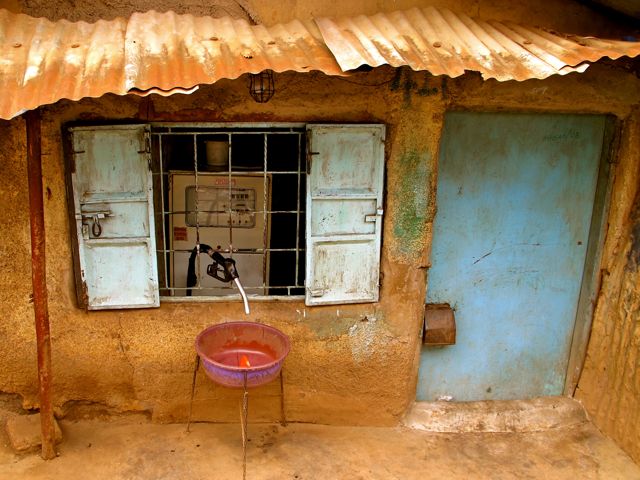
There are two parts of Kibera: the legal and the illegal. In the illegal side, fires are a constant threat due to indoor cooking practices inside the cluttered mud huts.
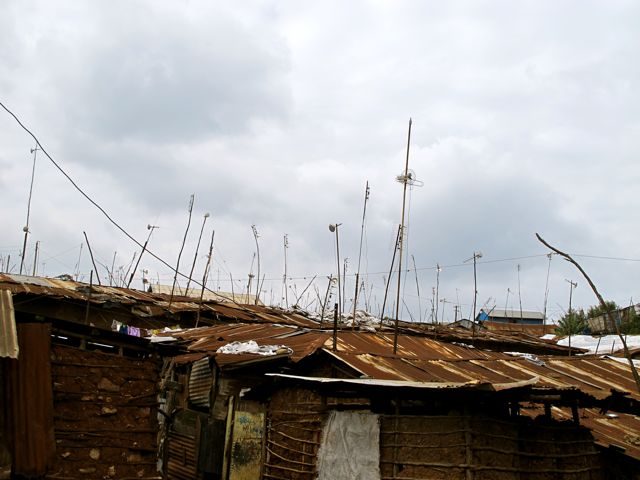
When it rains, the haphazardly connected electrical wires are a major threat, often resulting in injury and death.

Kibera has an open sewage “system.” The plastic water pipes that run over the raw sewage often develop holes, resulting in contamination.
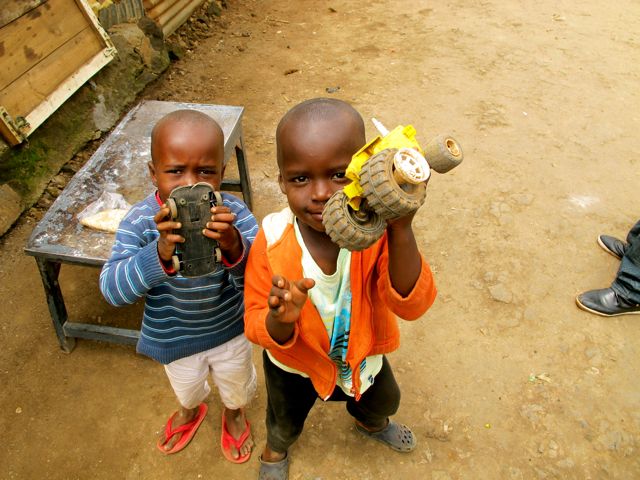
But, of course, kids enjoy toy cars in Kibera as they would anywhere.
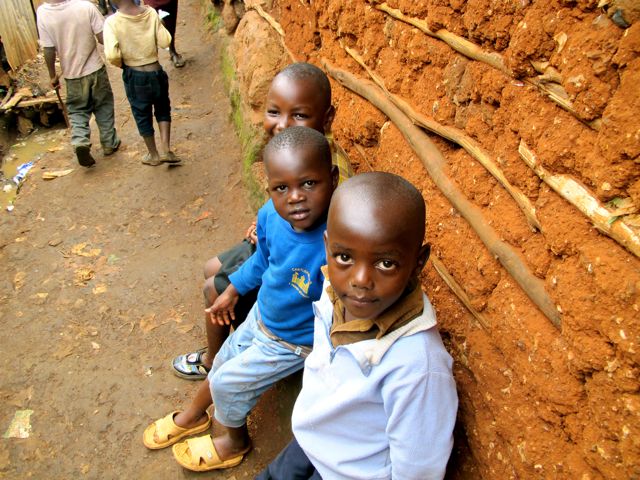
According to one resident, “Everyone comes to the slum through another person. You can’t just come today and start living. No one would accept you.”
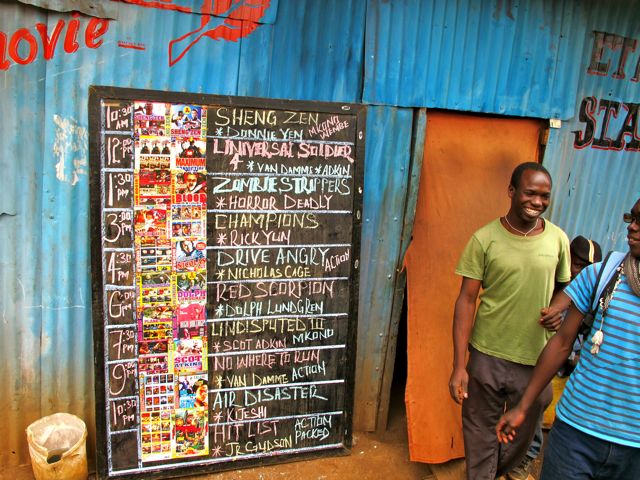
For entertainment, a mere 40 cents will allow you to catch a flick in Kibera.
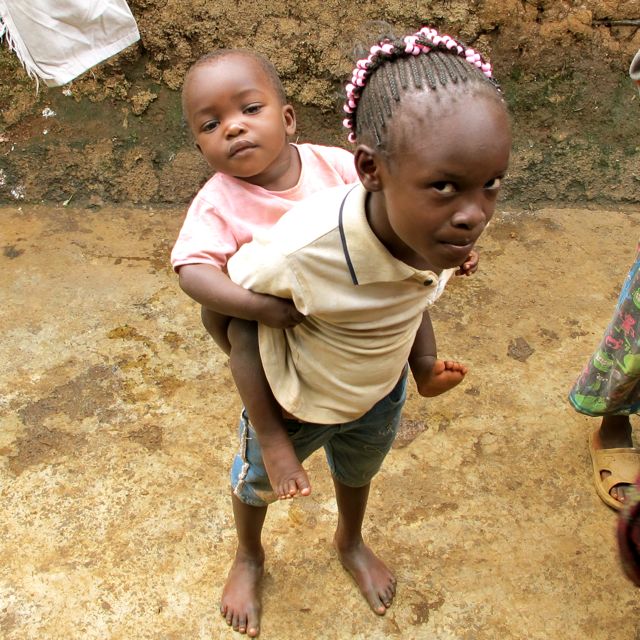
There is no police station inside the slum. They are located outside. “For them to follow your case, you need to bribe them,” one resident informed me. Normally they go to the chief.
• Read the entire “Luke in Kenya” series here.

About the Author
 After setting out to hitchhike from Chile to Alaska, Luke Maguire Armstrong stopped in Guatemala where he spent four years directing the social service programs of the charity Nuestros Ahijados. He is the author of, iPoems for the Dolphins to Click Home About (available for sale on Amazon.com) which is especially enjoyed by people “who don’t read poetry.” (Follow Luke on Twitter: @lukespartacus). His new book, How We Are Human, was recently released.
After setting out to hitchhike from Chile to Alaska, Luke Maguire Armstrong stopped in Guatemala where he spent four years directing the social service programs of the charity Nuestros Ahijados. He is the author of, iPoems for the Dolphins to Click Home About (available for sale on Amazon.com) which is especially enjoyed by people “who don’t read poetry.” (Follow Luke on Twitter: @lukespartacus). His new book, How We Are Human, was recently released.
The post Luke In Kenya Part 2: Nairobi’s Kibera Slum [Photo Essay] appeared first on The Expeditioner Travel Site.
]]>The post Luke In Kenya Part 1: Flying Into A New Year/World appeared first on The Expeditioner Travel Site.
]]>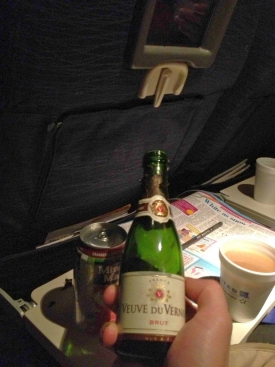
Luke in Kenya: Part 1
“Luke in Kenya” is a travel series from Managing Editor Luke Armstrong as he travels to Kenya to visit the homeland of his adopted brother.
Two days before my departure, my adopted Kenyan brother wrote (succinctly I may add), “Hey Luke, I just realized that you really suck at making a flight itinerary.” He was right. I flew out of Minneapolis at 5 p.m. on December 31 and arrived in Nairobi at 4 a.m. on January 2, connecting in Chicago, London and Cairo before my plane-weary body touched down in Nairobi. There are better ways to make this trip.
But I looked forward to two days in a limbo I’ve learned to love: airports. Flights lend themselves to a revealing sort of reflection — a contemplation of the place left and consideration of the destination to come. Each flight was filled with a distinctive cast of characters. A flight attendant on my MSP-CHI leg had a dress hanging in the airplane’s closet so that she could rush a few minutes late to a wedding reception upon arrival. She kindly gave me two free drink vouchers for my CHI-LON leg. “If you’re going to be flying over New Year’s Eve, you should probably have some champagne on the house,” she told me.
On my CHI-LON leg I sat next to Trace, a woman who shared my champagne and unabashedly told me how the best day of her life was when her son turned 18 and left the nest for good. “Some people should never be mothers,” she said. “He’s a sweet kid, and I was kind to him. It’s great having him now, but if I could do it over again, I would have never been a mother.”
Trace was on a way ticket to meeting her British boyfriend on his turf. The last hour of the eight-hour flight she spent fixing her makeup in anticipation of her amorous rendezvous. He promised to meet her cab from the airport with chilled champagne to toast the new year and their new life together. “I don’t know how I’ll do it,” she said, “but I’m not going back to Ohio.”
Flying form London to Cairo on Egypt Air I sat next to Lucha — an woman in her seventies wearing a gaudy collection of glittering gold jewelry. When I inquired about her family, she told me without emotion, “I’m sorry to tell you this, but they are all dead.” Later, when she opened up and her frowned turned to light laughter, she told me about her granddaughter, making me doubt the veracity of her earlier statement. This flight was also the only one I’d been on where a group of children were allowed to run up and down the aisle of the plane.
“That woman is from Somalia,” Lucha said, pointing out a large woman in a hijab. Later she waved this stranger over and said something in Arabic to her. “I told her,” she translated, “to run up and down the aisle to lose some weight. I think she is pregnant.”
On my last leg — a full day after I’d left the U.S. — I sat next to Steve, a 21-year-old American Political Science major who was six months into his gap year in Jordan. “I’m not supposed to be speaking English,” he informed me. “Arabic is a tough language and I signed a contract to only speak Arabic for a year.” But, since he was on vacation and spending two weeks in Kenya, he decided that English was okay.
*
When I arrived I went straight to the ATM, which promptly ate my card. I’d retrieve it later that afternoon from the bank after several calls and plenty of “uh-oh” thoughts.
When my brother Calvin arrived at the airport at 5 a.m. to meet me, he introduced me to his cousin Anita, part of my brother’s family I had come to Kenya to know, since in a way, they are also part of my family.
“Welcome to Kenya. Our cab driver is being arrested,” he said as he we walked out to the road. “They’ll release him soon. They’re just looking for a bribe. The police here would sell their own mothers for money.”
When our cab driver returned, we’d barely pulled out of the parking lot before the police detained him again. This time they told him his vehicle was not roadworthy. But 200 Kenyan shillings helped make it legal again. My brother laughed, “They saw that now he had a Muzungu (a foreigner) and figured he was now good for some more money.”
In the remaining darkness of night, our driver put his un-roadworthy vehicle in gear and we headed for Calvin’s uncle’s house, where I’d be staying for 10 days in Nairobi until my other brother Tyler arrived and we departed for the village where Calvin grew up. Until then, time for this Muzungu to explore.

• Read the entire “Luke in Kenya” series here.
About the Author
 After setting out to hitchhike from Chile to Alaska, Luke Maguire Armstrong stopped in Guatemala where he spent four years directing the social service programs of the charity Nuestros Ahijados. He is the author of, iPoems for the Dolphins to Click Home About (available for sale on Amazon.com) which is especially enjoyed by people “who don’t read poetry.” (Follow Luke on Twitter: @lukespartacus). His new book, How We Are Human, was recently released.
After setting out to hitchhike from Chile to Alaska, Luke Maguire Armstrong stopped in Guatemala where he spent four years directing the social service programs of the charity Nuestros Ahijados. He is the author of, iPoems for the Dolphins to Click Home About (available for sale on Amazon.com) which is especially enjoyed by people “who don’t read poetry.” (Follow Luke on Twitter: @lukespartacus). His new book, How We Are Human, was recently released.
The post Luke In Kenya Part 1: Flying Into A New Year/World appeared first on The Expeditioner Travel Site.
]]>The post Pack The Pants James Bond Would Wear If He Were A Backpacker appeared first on The Expeditioner Travel Site.
]]>
Everyday, people all over the world wake up and put on pants. With their britches donned, they dash off to class, their tractors, their grocery stores, the nearest mall or to their offices where they will spend their day in trousers sitting in cubicles, compulsively checking their Facebook status and avoiding eye contact with upper management.
One faction of intrepid pants-wearers have no idea where the morning will lead them. That day they may scamper through Asian markets, board Central American buses, walk through foreign central squares overrun with pickpocketers or hike jungle trails. These, the traveling sect, often wear the same pants as everyone else, instead of gear designed specifically for their plucky lifestyle.
Clothes are about more than just hiding nakedness. They are tools that serve a function. Being someone who has had four iPods stolen abroad in the last five years, I can tell you keeping your valuables on your person is not always easy. It’s good to have some support on the front lines, and P^Cubed Travel Pants from Clothing Arts are designed with you, the traveler in mind.
This week I got my legs into a pair of these pants (a pair of which Clothing Arts provided to me for this review), and I gave them a test drive. Having worn pants for 27 years, I consider myself an expert. The first thing I did was analyze the most important feature: girl-ability. I was at a potluck and asked two girls I’d just met what they thought of them. They said they were nice pants and looked good. Score!
They also felt pretty good. Early on in my pants experience, I decided that the P^Cubed Pants were the sort of pants James Bond would wear. The pants come in both adventure (cargo-style) and business (sans side pockets) style. The adventure style are made from 25% nylon and 75% cotton canvas, and whose 10-pound tearing strength make them “bomb proof” (finally!). The business-style clock in at comfortable 100% cotton twill. Both models have four built-in money belts.
Unless unconsciousness is involved, I can’t really imagine a pickpocket’s fingers touching anything in these pants. The standard side pockets have an inner pocket inside them, protected by a zipper, sealed off by The P^Cubed-buttoned pocket guard. The expandable cargo pockets also contain inner pockets buffered by buttons and sealed off by snaps. Throw in a detachable water bottle pouch and seal the deal with water/oil-resist stain-releasing Teflon fabric protector, and you’re left with a pair of road pants that deliver everything you could reasonably ask for out of an article clothing. I think the only thing these pants don’t do is make phone calls. I know: I tried.
The back pockets are big enough for your Lonely Planet, and they will work as well with a blazer for a soirée in Paris as they will for a twenty-mile trek into the Australian bush. When I go to Kenya next month, my P^Cubed’s are going to be the first pants I pack.

About the Author
 Luke Maguire Armstrong (TravelWriteSing.com) once fought a bear and almost died. Haters later claimed it was “only a raccoon” and that he was acting like “a little girl.” After spending five years in Latin America, four spent directing the social service programs of the charity Nuestros Ahijados in Guatemala, he’s turned up in New York City because he heard that they have great Thai food. He is the author of iPoems for the Dolphins to Click Home About (available for sale on Amazon.com), and his newest book, How We Are Human. Follow @LukeSpartacus.
Luke Maguire Armstrong (TravelWriteSing.com) once fought a bear and almost died. Haters later claimed it was “only a raccoon” and that he was acting like “a little girl.” After spending five years in Latin America, four spent directing the social service programs of the charity Nuestros Ahijados in Guatemala, he’s turned up in New York City because he heard that they have great Thai food. He is the author of iPoems for the Dolphins to Click Home About (available for sale on Amazon.com), and his newest book, How We Are Human. Follow @LukeSpartacus.
The post Pack The Pants James Bond Would Wear If He Were A Backpacker appeared first on The Expeditioner Travel Site.
]]>The post How Has Hurricane Sandy Affected Travel In New York City? appeared first on The Expeditioner Travel Site.
]]>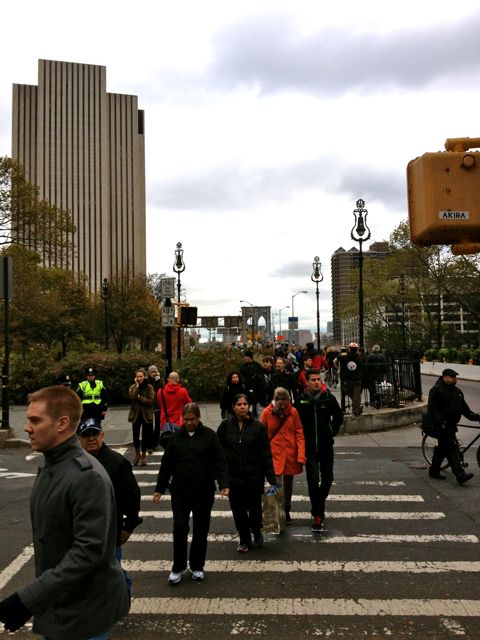
When I was typing the first sentence of this post, the New York City Marathon was on. I was going to raise the question as to whether or not our readers thought that decision was a good call considering the controversy that was erupting over the mayor’s decision to proceed with it. New York City sets its watch fast. Studies have even shown that New Yorkers even walk faster than most people on the planet. “This city is a city where we have to go on,” Mayor Bloomberg said on Wednesday. He saw the Marathon as the vehicle to show New Yorkers that things were normalizing. That and the $300 million it brings in would have been a nice booster to an economy that’s taken some gut punches from Sandy.
One newscaster said on a local Brooklyn newscast that “[h]olding the Marathon now would be like having a rowing competition in New Orleans right after New Orleans.”
But now the marathon is off. Canceled Sorry about Sandy, come again next year. No matter what the decision was going to be, the result was bound to anger some. Laura Schwecherl, a Brooklyner who was planning to run the race this weekend, voiced frustration that many other runners are likely feeling. “I think it’s the right decision, but they should have figured their shit out earlier.”
A statement today from the mayor’s office, which stills maintains that city resources would not have been directed to the marathon, summed up their decision by arguing, essentially, that it simply would have been in bad taste. “We do not want a cloud hanging over the marathon and the runners so we decided to cancel it.”
This is going to cause many people who had planned to travel to New York to refrain from doing so. This is good in the short term, but bad in the long term recovery of New York’s economy.
A hotel manager in the East Village I spoke with, who wanted to remain anonymous because she was “not sure if [she] was allowed to talk to reporters”, said that they’ve received a steady stream of cancellations due to the cancellation of the race, but that many of those rooms are being claimed by people currently displaced from her home.
“With power out in a lot of Manhattan,” she said, “it would be strange for anyone who doesn’t have to be here to come.”
Though you can expect New York City to recovery with the speed that it does everything else, travelers and tourists will likely begin to start to start trickling back in over the coming weeks when New Yorkers resume their quick pace and walk away from all things Sandy.

About the Author
 After setting out to hitchhike from Chile to Alaska, Luke Maguire Armstrong stopped in Guatemala where he spent four years directing the social service programs of the charity Nuestros Ahijados. He is the author of, iPoems for the Dolphins to Click Home About (available for sale on Amazon.com) which is especially enjoyed by people “who don’t read poetry.” (Follow Luke on Twitter: @lukespartacus). His new book, How We Are Human, was recently released.
After setting out to hitchhike from Chile to Alaska, Luke Maguire Armstrong stopped in Guatemala where he spent four years directing the social service programs of the charity Nuestros Ahijados. He is the author of, iPoems for the Dolphins to Click Home About (available for sale on Amazon.com) which is especially enjoyed by people “who don’t read poetry.” (Follow Luke on Twitter: @lukespartacus). His new book, How We Are Human, was recently released.
The post How Has Hurricane Sandy Affected Travel In New York City? appeared first on The Expeditioner Travel Site.
]]>The post How To Help Invest In The Future Of Guatemala appeared first on The Expeditioner Travel Site.
]]>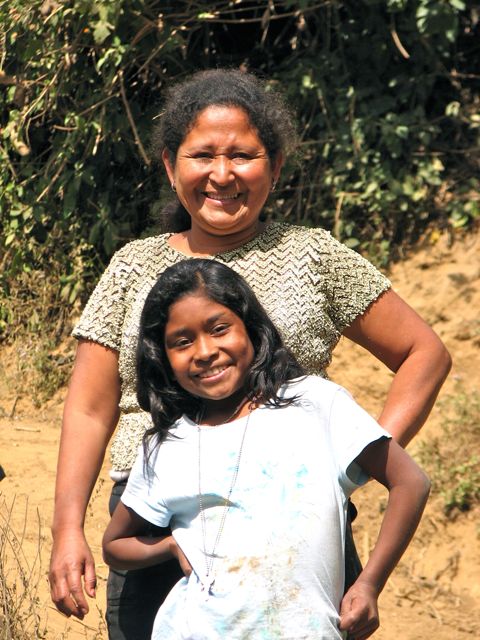
In the current presidential election there is a lot of talk about safety nets. Without being political, I’ll say that the most in the developed world have them, and they tend to be pretty effective overall.
In the third world, these nets often don’t exist, or are filled with human-sized holes. What this means is that when things go bad, they get worse and the sinking often doesn’t stop until things hit rock bottom. Rock bottom may mean homelessness, disease or, at the severest, loss of life. This is nothing new. The sick often become poor and the poor often get sick.
People at the bottom rung of the economic chain live day-to-day doing whatever they can to survive. On a bad day they might earn nothing; on a good day maybe they’ll earn $10. In my experience working with these populations, I’ve seen that the same family one month might earn $100 and the next month earn $300. What those two months have in common is how much is left over at the end of it: typically nothing.
The reason is often the result of lack of financial education. The poorest populations typically have little by way of experience handling finances. For many who are able to save, money is likely to be stashed in a mattress where it is vulnerable to thieves. The poor, more than any other population, would benefit dramatically by having a meager savings to help them over rough months when they don’t earn enough to even properly feed themselves or provide for needed medicine or school supplies. I’ve encountered families who chose not to send their kids to school simply because they couldn’t afford $20 in school supplies.
In the development field, most would agree that for many poor people with some regular income, having a savings would benefit them greatly. The question that results is: How do you do that? How do you get people with no financial education to learn how to manage their finances?
In Guatemala The Integral Heart Foundation is currently micro-testing an answer to this question by implementing a pilot project called The Third World Savings Project. The project consists of three simple parts:
1) Teaching impoverished families who have had no formal education how a bank savings account works.
2) Pairing them up with a mentor (local Guatemala university students), who can help them understand their finances better and make better financial choices.
3) Opening a bank account with them and then offering them the following incentive: If they make a deposit of any amount every week for six weeks in a row, $50 will be deposited into their savings account.
The end goal of this project is to help participating individuals see the value of having the safety net of a savings account and continue to use their new account. Even if 10% of the families in the pilot program continue after the pilot period, the program could be considered a success.
So will it work? We’re not sure. But we’re excited to find out and to learn how this idea pans out in the real world.
And this grassroots program needs your help. We are looking for 10 sponsors to sponsors 10 families in order to fund the program. If you are able to be one of them, please click here to learn more and help rewrite the rules of the game for one poor family in Guatemala.

About the Author
 After setting out to hitchhike from Chile to Alaska, Luke Maguire Armstrong stopped in Guatemala where he spent four years directing the social service programs of the charity Nuestros Ahijados. He is the curator of the high energy humor site Rabble Rouse The World and his book of poetry, iPoems for the Dolphins to Click Home About (available for sale on Amazon.com) is especially enjoyed by people who “don’t read poetry.” Look for his next poetry book, “How We Are Human,” this fall, and his novel “How One Guitar To Save To World” whenever he finally finds an agent.
After setting out to hitchhike from Chile to Alaska, Luke Maguire Armstrong stopped in Guatemala where he spent four years directing the social service programs of the charity Nuestros Ahijados. He is the curator of the high energy humor site Rabble Rouse The World and his book of poetry, iPoems for the Dolphins to Click Home About (available for sale on Amazon.com) is especially enjoyed by people who “don’t read poetry.” Look for his next poetry book, “How We Are Human,” this fall, and his novel “How One Guitar To Save To World” whenever he finally finds an agent.
(Follow Luke on Twitter: @lukespartacus).
The post How To Help Invest In The Future Of Guatemala appeared first on The Expeditioner Travel Site.
]]>The post Change The World By Doing Things You Love appeared first on The Expeditioner Travel Site.
]]>
On The Expeditioner and plenty of other travel sites, there is an ongoing debate among travelers. It’s more of an agreement than a debate. Plane-loads of travelers not only want to see far-off lands, they want to put their time, talent and treasure towards a good cause along they way.
It’s wonderful to hear about the commendable efforts others are doing. Although at least in my case, I tend to feel a little guilty when I learn about those efforts. It starts slow. You hear about someone doing something amazing and your gut reaction is, “Hooray!” But then you get about two-thirds the way through the article and you begin to think, “Wait a minute, this person is a much better person than me. Crap. Why am I such a waste of carbon?”
That first voice — the “Hooray!” one — is the one you want to listen to. That’s the one that’s encouraging and allows you to be inspired by the good deeds of others to the point of taking bigger steps in your own life and travels to help others. That second voice? He’s a jerk. He just wants you to feel bad all the time. That’s the same voice that says things like, “That girl at the bar? No, don’t talk to her. She’s way out of your league. True, I should listen to that voice sometimes — but only when I’m at the bar.
I’m going somewhere with all this. While I was working in development in Guatemala, I met a couple, Mick and Debora, who founded a charity called The Integral Heart Foundation (IHF).
The organization’s stated mission per their website is:
Creating conscious leaders through heart-centered sponsorship and educational programs which include the development of mind, body, spirit and emotions. We are doing this, not by teaching our students what to think, but how to think for themselves.
They also do solar. For the past three years they have been working in remote villages, centering their efforts in one Guatemalan village called Mano de León. They’ve opened up two kindergartens this year to promote education at an early age. (Those kindergarten are using some of my old furniture, which I hope is covered in crayon.)
More than providing education at an early age, they have been installing solar energy lighting units in the village that was completely off the grid. People there were spending up to $250 a year on candles. For many families, that was more than their monthly income. Now, 11 of those 21 houses are solar-powered.
IHF isn’t stopping there. They plan to increase safety and the sense of well-being in the community by lining the dark streets with solar lanterns. They also want to power the school, which would allow for more of its budget to be put towards buying educational resources and books.
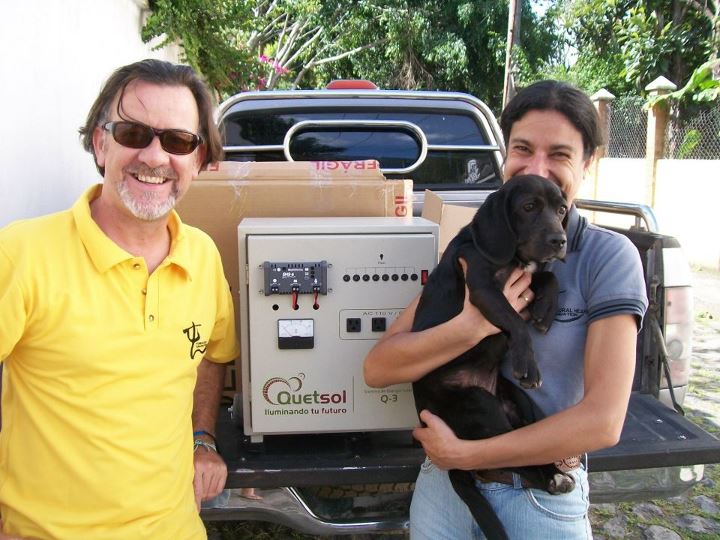
Something that has always impressed me with IHF is Mick and Deborah’s ability to network with others to accomplish their philanthropic goals. To this end, two riders in California’s Climate Ride 2012, Christopher Porto and Elizabeth Schorn, are using their ride to raise money and awareness for IHF’s solar goals in Mano de León. It’s an example of how the things we do because we have a passion for (bike riding, traveling, racing, tabogonging, etc . . . ) can be used for philantropic ends.
To find out more information and to help Christopher and Elizabeth Schorn reach their goal, click through here.
Mick Quick Explains More About the Solar Bike Ride Fundraiser
From September 9-14, Climate Ride 2012 in California will host hundreds of cyclists and activists from around the world for a 300-mile journey to build awareness of and promote sustainable solutions to climate change.
For this charitable bike ride, Porto and Schorn will be fundraising on behalf of IHF to support the expansion of their solar light program. Known as Project Aurora, this initiative will seek to raise $4,800+ to support IHF’s efforts to raise the standard of living for the 110 villagers of Mano de Leon, Guatemala, by deploying solar-powered lighting on both homes and schools.

The Mayan village of Mano de Leon is located in the middle of a large private coffee plantation. There are about 110 people (21 families) in total. Ten of these families live in single-room structures with tin roofing, and the remainder have cinder-block homes. The residents of Mano de Leon currently have no running water, eight of the homes have no light and only one paid teacher for all grades of 50 children.
The elevation is 6,600 feet, that’s about 1,400 feet above the level at which you can find public transportation. Yet, despite the fact that it is only three miles from the Spanish Colonial city of La Antigua Guatemala, it takes 20 minutes to drive up to Mano de Leon by 4×4. The road is very steep and winding. This also means that if the villagers want to visit the nearest town, the round trip is over four hours of walking.
IHF is an organization that is dedicated to bringing integral education and clean energy to off-grid villages in Guatemala. There are millions of people living in Guatemala that do not have access to electricity and are exposed to dangerous smoke from the candles they use at night. It is both toxic for the families and very difficult for the children to read at night by candlelight.
Porto and Schorn will be using the donations received to source and install solar systems for those facing energy poverty in the hopes of enabling young minds to create a cleaner and brighter future for us all.

About the Author
 After setting out to hitchhike from Chile to Alaska, Luke Maguire Armstrong stopped in Guatemala where he spent four years directing the social service programs of the charity Nuestros Ahijados. He is the curator of the high energy humor site Rabble Rouse The World and his book of poetry, iPoems for the Dolphins to Click Home About (available for sale on Amazon.com) is especially enjoyed by people who “don’t read poetry.” Look for his next poetry book, “How We Are Human,” this fall, and his novel “How One Guitar To Save To World” whenever he finally finds an agent.
After setting out to hitchhike from Chile to Alaska, Luke Maguire Armstrong stopped in Guatemala where he spent four years directing the social service programs of the charity Nuestros Ahijados. He is the curator of the high energy humor site Rabble Rouse The World and his book of poetry, iPoems for the Dolphins to Click Home About (available for sale on Amazon.com) is especially enjoyed by people who “don’t read poetry.” Look for his next poetry book, “How We Are Human,” this fall, and his novel “How One Guitar To Save To World” whenever he finally finds an agent.
(Follow Luke on Twitter: @lukespartacus).
The post Change The World By Doing Things You Love appeared first on The Expeditioner Travel Site.
]]>The post To Help Or Not To Help? appeared first on The Expeditioner Travel Site.
]]>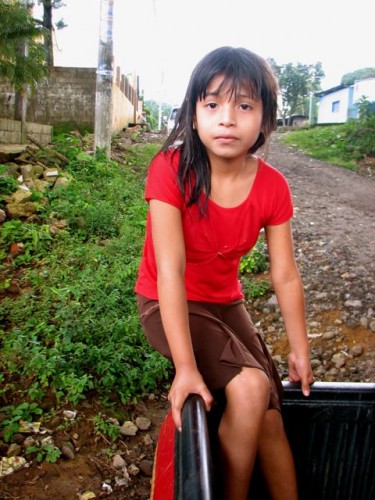
Note: Author and TheExpeditioner.com managing editor Luke Armstrong recently “sold out” and launched a personal blog, Travel. Write. Sing.
Last Sunday the New York Times ran an article that asked a question in the headline, “Can travel make the child?” The author explored whether philanthropic travel can be positive and formative for your kids on early on.
Not surprisingly, the article concluded that, yes, sending your young-ins off on charity work can can have a very moving and positive impact when done at an early age. Realistically, this was the inevitable conclusion; the article hardly would have been inspiring had it concluded, no, your kids shouldn’t travel around to help people, you’d be better off sticking them on a cruise ship.
Besides just answering the title question, the piece also explored practical questions about how to prepare, how young is too young, how much is too much, whether trips should be mixed with service and pleasure and how that experience can translate when they return home.
All very important questions the author did a good job of answering by providing real-life instances of philanthropic traveling paying inspiring dividends.
In my own life, a charity trip I took to Guatemala to build houses when I was 13 was very formative. (I returned a decade later and spent the next four years working professionally for the same charity.)
My last journal entries from the time highlight how important this experience was for me in my life.
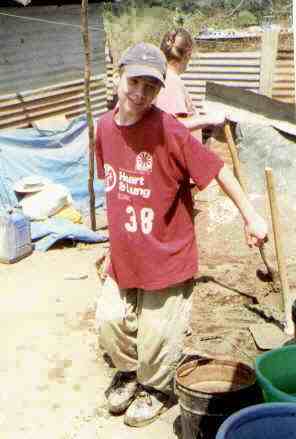
3-2-2000
Well, tomorrow I will be going home. This trip has touched me in so many ways. It has opened my heart to love. Words could never explain how it has touched me. Only those inner emotions that guide me can make me remember, tomorrow I leave, but I shall return, let me always carry with me what I found here so it an never be forgotten.
For me that trip early on — seeing the poor as they were, doing something to make their lives better, building them a house — became a staging ground for determining what are worthwhile pursuits in this life.
I don’t think there will be many dissenters at this point. You rarely come across someone who is against giving a young person the opportunity to use his or herself as a means for improving other’s lives.
Assuming we all agree, it leads to another, very important question, “How do you find a good organization to volunteer with?”
Answering this question is the difference between making a real difference and wasting your time and money.
The founder of the charity I worked for, Patrick Atkinson, used to dub certain organizations as “Charities for Fun and Profit.” Meaning, they seem pretty good, but they aren’t really doing anything. One of the things he instilled in me was an aversion to charities charging an unrealistic service fee. He believed, as I do, that people stretching their budgets to volunteer abroad shouldn’t be taken advantage of.
There are some organizations that will literally charge you $100 a day to put a broom in your hand to and sweep floors. Who sweeps the floors when there aren’t volunteers paying to do? The paid janitor. When working with these organizations, the question, “Did I really make a difference?” might not have a positive answer.
Critics might argue that organizations need to charge high administrative fees in order to stay in business. To that I would counter that any charity that can’t find a funding model outside of extorting its volunteers likely has equally uninspiring solutions to issues like poverty.
Many of the volunteers I’ve met abroad often save for years to be able to do so, pinching every penny to fulfill their philanthropic dreams. Thousands of dollars in administrative fees need not be part of that dream.
So what can you do? Online, any place can seem as if they are doing amazing work. How can you tell which ones are exploitative?
First, do more than a Google search. When you find a charity that seems to have what you are looking for, email them, call them and ask the right questions. What exactly are the fees and are they reasonable? Ask for all costs to be itemized.
If they are charging you $100 to house you and it turns out that the place housing you is only receiving $25 dollars, that’s a problem. Ask them to put you in touch with volunteers who have worked with them and contact them. Find out what they did, how things were went. Was it efficient? Do they feel they made a real difference?
Second, keep in mind that former volunteers are one of your best lines of defenses before you sign on. They’ve been there, and usually once you’re on the ground, it becomes clear whether the organization has a worthwhile solution to the problems it is posing to remedy.
Volunteering abroad isn’t cheap, but it can be one of the most rewarding experiences of your life. Most importantly, you’re given the chance to change the life of someone in need. One bad service trip not only wastes your time and money, it can make you cynical of the “good guys,” the worthwhile charities with the good intentions and compelling solutions. Take the time to find the right ones long before you or your offspring board the plane.

About the Author
 After setting out to hitchhike from Chile to Alaska, Luke Maguire Armstrong stopped in Guatemala where he spent four years directing the social service programs of the charity Nuestros Ahijados. He is the curator of the high energy humor site Rabble Rouse The World and his book of poetry, iPoems for the Dolphins to Click Home About (available for sale on Amazon.com) is especially enjoyed by people who “don’t read poetry.” Look for his next poetry book, “How We Are Human,” this fall, and his novel “How One Guitar To Save To World” whenever he finally finds an agent.
After setting out to hitchhike from Chile to Alaska, Luke Maguire Armstrong stopped in Guatemala where he spent four years directing the social service programs of the charity Nuestros Ahijados. He is the curator of the high energy humor site Rabble Rouse The World and his book of poetry, iPoems for the Dolphins to Click Home About (available for sale on Amazon.com) is especially enjoyed by people who “don’t read poetry.” Look for his next poetry book, “How We Are Human,” this fall, and his novel “How One Guitar To Save To World” whenever he finally finds an agent.
(Follow Luke on Twitter: @lukespartacus).
The post To Help Or Not To Help? appeared first on The Expeditioner Travel Site.
]]>The post All Those Months On The Road Were Actually Making You Sexier appeared first on The Expeditioner Travel Site.
]]>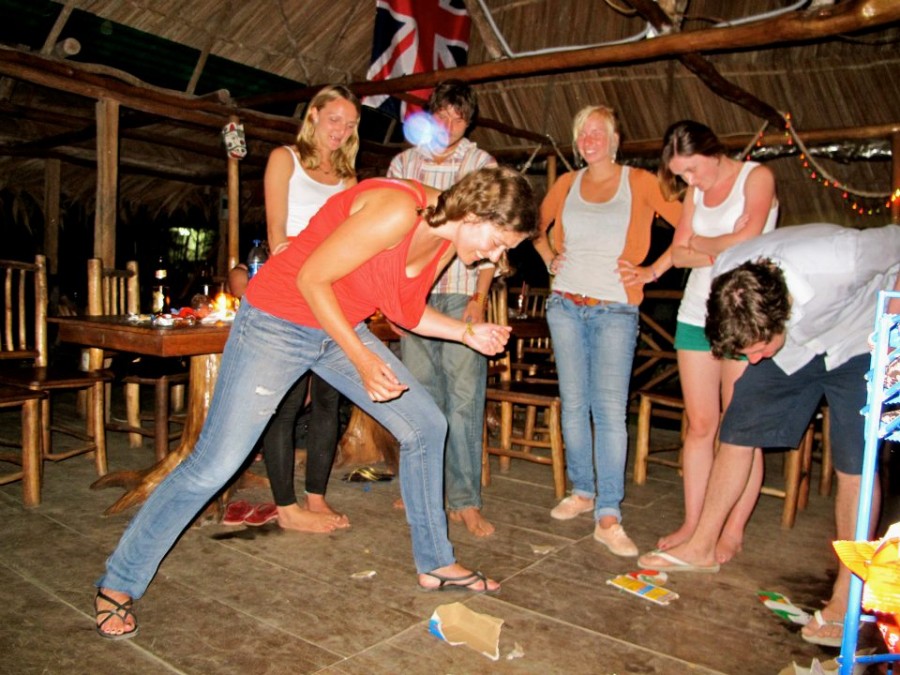
“Tell me baby, where have you been?”
“Oh, baby, I’ve been everywhere. From the temples of Tibet to the beaches of Barcelona. Do you like that?”
“Oh yes! Tell me more. Please tell me more.”
“After college I took a gap year — went all over Europe.”
“Yes. Keep going!”
“I studied abroad in Norway one semester and during the breaks I traveled to Sweden.”
“Yes?”
“And Denmark — ”
“Yes! Where else? Where else did you go?”
“Everywhere baby! I’ve been everywhere!”
Perhaps the only thing that attracts me more than a hipster girl reading a book alone at the edge of a dive bar is a traveling girl with a craze for throwing her essentials into an oversized pack, hailing a cab, catching a plane and throwing her hot self to some far-flung corner of the world.
I think that instead of investing in expensive cosmetic surgery, people would be better off buying a plane ticket. Traveling is not only awesome but travelers are the sexiest thing ever to come to Sexy Town.
And it’s not just me who thinks so. According to the New Zeland Herald’s aptly titled article, “Travel’s sexy . . . and the Aussies know it,” a survey of Australians found that of all the characteristics that make a potential date most appealing, travel is number one.
Jo Stewart, a spokeswoman for an online dating site was quoted in the article saying, “Travelers are generally considered curious about the world, open-minded and adventurous — all of which are attractive qualities.”
That’s right traveler, all those months you’ve logged on the road were doing more than just giving you cooler Facebook albums than your stay-at-home friends and draining your bank account. Without knowing it you were also sexifying yourself, making you more attractive to a potential partner.
It makes sense now, doesn’t it, why every hostel has romance coursing through the air like dust? What do we think is going to happen when a sect of the sexiest people on the planet (travelers, holla!) are forced to share a dorm room?
All this bodes very well for everyone’s self esteem here at The Expeditioner. Nothing is official yet, but talks are underway. We’re thinking about adding an S in front of the E.

About the Author
 After setting out to hitchhike from Chile to Alaska, Luke Maguire Armstrong stopped in Guatemala where he spent four years directing the social service programs of the charity Nuestros Ahijados. He is the curator of the high energy humor site, Rabble Rouse The World, and his book of poetry, iPoems for the Dolphins to Click Home About (available for sale on Amazon.com) is especially enjoyed by people who “don’t read poetry.” He also just sold out and launched a personal blog, Travel. Write. Sing.
After setting out to hitchhike from Chile to Alaska, Luke Maguire Armstrong stopped in Guatemala where he spent four years directing the social service programs of the charity Nuestros Ahijados. He is the curator of the high energy humor site, Rabble Rouse The World, and his book of poetry, iPoems for the Dolphins to Click Home About (available for sale on Amazon.com) is especially enjoyed by people who “don’t read poetry.” He also just sold out and launched a personal blog, Travel. Write. Sing.
(Follow Luke on Twitter: @lukespartacus).
The post All Those Months On The Road Were Actually Making You Sexier appeared first on The Expeditioner Travel Site.
]]>The post 8 Reasons To Visit Detroit (No, Really) appeared first on The Expeditioner Travel Site.
]]>
Really, Detroit? Yes, Detroit.
I know, you’ve heard all the news. You’ve watched the documentaries. You’ve looked at photos of abandoned buildings and heard that you can buy houses in Detroit (wasteland that it is) for a nickel.
But people’s criticisms of Detroit come mainly from comparing it with what it was. Detroit is not, nor will it ever again be, the Industrial Revolution’s Mecca in the United States. But the city that paved the first road in the U.S. still has a lot to offer, both in terms of regular traveling diversions, as well as for sights that are unique to Detroit.
My cousin Philip, who’s lived here his whole life, says something you don’t hear a lot of these days, “I love Detroit.” He sees Detroit as a blank slate. Detroit may not be what it was, but it is what it is, and no one is exactly sure the direction it will take, making it one of the most interesting U.S. cities to visit right now.
So while I was in Detroit, I asked locals for reasons to visit and they came up with a list of the top 8 reasons to make a trek to The Motor City.
1) Bowling Alleys
Detroit has the most bowling alleys per capita.And it’s not just because no one lives in Detroit anymore: They’ve had the most bowling alleys for like, a long time. And from what I saw, most of this alleys have bars, and where there’s drinking and 10-pound balls of rock, there’s always a good time.
2) Heidelberg Project
It’s one of those “have to be there to understand it” type places. Since 1988, a collective of artists have lived in a neighborhood that the city originally wanted to level (and which they did manage to destroy a number of houses). Today, the eclectic artists now proudly display their artwork around and on the abandoned houses, much of which is found art made from the rubble of the city. Check out more pictures here.

3) Canada
Canada is just a ferry ride away. And have you ever met a Canadian you didn’t like? Exactly. And at the time of publication, the exchange rate was slightly in favor of the U.S. dollar (1 to 1.02). Take that Canada! We’re coming back!
4) Lots of Water
From riverfronts to giant lakes (great ones) — luckily, when everyone left Detroit, they left the water. So for water enthusiasts and fish, the Detroit River still offers a wide array of fun in the sun.
5) Sports
Hockey fan? Baseball fan? Football fan? Well, with a trio of professional sports teams, Detroit can hook you up with some front-row tickets to events that people with fantasy leagues only dream about.
6) Techno Music
Bum, bum, bum, bum, “around the world, around the world, around the world . . .” Did you know that Detroit is the birthplace of techno? That’s right lil’ Moby, it started here. And the scene is still strong. Every year at the end of May you can grab your glowsticks and body paint and rock out at the Detroit Electronic Music Festival! Or, you know, you can just like, stand there and nod your head to the beat.
7) Specialty Dancing
I don’t really want to put this on the list, but when I asked a petite girl at a bowling alley (and bar) my question, “What is there to do in Detroit?” her face immediately lit up and she starting telling me about all the strip clubs, offering to take me. So, um, yeah, there’s a lot of those in Detroit, mostly because nobody can afford clothes since all the plants closed.
8) Modern Ruins
All around Detroit are modern ruins in the making. Even though Detroit officials are keen on tearing down abandoned buildings and crack houses, they are popping up faster than you can say, “Hey, I’m squatting here!” So, though it’s a bit moribund and creepy, it’s hella interesting to see modern ruins in the making. One must-see crumbling bit of post-apocolyptic destruction is the old train station which stopped running in 1988. It’s so awesome, it gets its own spot on the list.

Detroit may be going through an uncertain transition, but it still has the uniqueness that sets it apart from other cities. It’s a piece of history in progress, and is the poster city of the death of the Industrial Revolution. It’s crazy, sad and interesting, but above all, it’s an experience worth having and one you’ll certainly remember.

About the Author
 After setting out to hitchhike from Chile to Alaska, Luke Maguire Armstrong stopped in Guatemala where he spent four years directing the social service programs of the charity Nuestros Ahijados. He is the curator of the high energy humor site, Rabble Rouse The World, and his book of poetry, iPoems for the Dolphins to Click Home About (available for sale on Amazon.com) is especially enjoyed by people who “don’t read poetry.” (Follow Luke on Twitter: @lukespartacus).
After setting out to hitchhike from Chile to Alaska, Luke Maguire Armstrong stopped in Guatemala where he spent four years directing the social service programs of the charity Nuestros Ahijados. He is the curator of the high energy humor site, Rabble Rouse The World, and his book of poetry, iPoems for the Dolphins to Click Home About (available for sale on Amazon.com) is especially enjoyed by people who “don’t read poetry.” (Follow Luke on Twitter: @lukespartacus).
The post 8 Reasons To Visit Detroit (No, Really) appeared first on The Expeditioner Travel Site.
]]>The post The Problem With Our Giant Piles Of Stuff appeared first on The Expeditioner Travel Site.
]]>
Editor’s Note: The author’s house was robbed just hours before this article was published, resulting in the loss of a computer, iPod, camera and various other items. The author plans to next publish an article about what it would be like winning the lottery and finding the cure for cancer.
If you had to get rid of five items in your house, which ones would you ditch? What about twenty? Two hundred? (I hope at this point you haven’t trashed any Batman-related items.) What if you could only own what you could carry on your back?
I thought about this today as I was cleaning my house. I enjoy house cleaning like I enjoy blind surgeons: not at all. And as I was doing it, I was imagining how wonderful it would be to never clean again. I could think of two scenarios where this could become reality. First would be finding the key to the closet where I accidentally locked my maid two years ago. Second would be getting rid of everything I own.
When I was finished cleaning, I stood back and marveled at how much stuff I had accumulated in my four years living here in Guatemala. It didn’t start this way. I arrived with just a backpack and guitar. After spending my last semester of college in Chile, I cast off everything that did not fit in my backpack or guitar case and started hitchhiking northward. Getting rid of all those things ended up being more complicated than initially envisioned, and can be re-lived by reading the mass e-mail I sent out on the subject.
I remember my backpack-and-guitar days fondly. It felt good to feel completely self contained. But eventually my backpack, guitar and I came to what has turned into a four-year stopover in Guatemala. In that time my pile of stuff has grown. Now it would probably take a few pickup loads to transport my stuff from here to there. My books alone would take several mules (I should have gotten that Kindle four years ago).
Even when I’m not cleaning (which is all the time), having all these things kind of stresses me out. I don’t plan on living in Guatemala my whole life and don’t even want to know how much it would cost to ship all of this stuff elsewhere. (My guess is about as much as it would cost to buy a spaceship.)
George Carlin was thinking along similar lines when he said, “A house is just a pile of stuff with a cover on it. You can see that when you’re taking off in an airplane. You look down, you see everybody’s got a little pile of stuff.”
So what happens if you just walk away from your pile of stuff?
Well, your plants die. But plants don’t like to be in captivity anyways. They want to be outside in the forest or on the range where seldom is heard a discouraging word and the sky is not cloudy all day.
 So aside from your plants (who hate you anyways) your stuff doesn’t need you. You need it. Actually, you spent a big chunk of time earning money to get that stuff. But are you really happy with all that stuff? Is there an alternative? Could anyone really get by permanently without a bunch of stuff? (Aside of course from Chester, the bum who lives in your alley.)
So aside from your plants (who hate you anyways) your stuff doesn’t need you. You need it. Actually, you spent a big chunk of time earning money to get that stuff. But are you really happy with all that stuff? Is there an alternative? Could anyone really get by permanently without a bunch of stuff? (Aside of course from Chester, the bum who lives in your alley.)
Well, lots of pimp people throughout history have shed the burden of owning things and set off into the world living off their wits: Kerouac, Jesus, Buddha, Thoreau, That Other Buddha, T.E. Lawrence (camels don’t count as stuff) . . . the list goes on.
All these people probably realized what that Buddha guy realized, which is that while we may own our things, we often can’t imagine life without things. So we base our lives around protecting our stuff, acquiring more stuff and protecting that stuff.
In his weekly “The Backpacker” column, Ben Groundwater of The Sydney Morning Herald’s recently wrote about his disillusionment at being owned by his things. Every time he travels abroad he thinks the same thought: “I own too much junk. Too much junk that I don’t need.” It’s when he is abroad that he really begins thinks he should “[g]ive it all away. Live more frugally. Never worry about losing stuff, because [he’d than] have no stuff to lose.”
But Groundwater admits, somewhat regretfully, that when he returns he falls into a familiar rut of buying new stuff and retaining the old.
And this is quite the paradox. While much of the world is worrying about how they are going to acquire things to, you know, eat and survive, those us in the first world spend out time bemoaning our ownership of stuff that most of the world will never have.
A simple reality remains: We are the ones with the choice. He concludes his article by griping about things he’s decided to do while abroad but still hasn’t. “I’ve decided to watch less TV, because I really don’t need it. But still haven’t. I’ve decided to take a photography course. But still haven’t. I’ve decided to do some simple volunteer work for a charity. But still haven’t.”
But you, I and Ben can do all these things. We, the privileged, can basically do anything we want, including owning a bunch of shit we don’t need while having existential crises about owning that shit.
And while getting rid of everything we own is an extreme way to go, we can adopt a perspective that loosens the hold our stuff has on us. We can strive to minimize our consumer-driven buying, and with every new purchase we can ask the crucial question, “Do I really need this? Could the money be better spent elsewhere? Could I use it to help someone else?”
In the end the most important thing to do is be grateful for what we have and realize just how lucky we are to have it. And that if we don’t want it, remember, it’s optional and someone else probably does. If we ever get to the point that our stuff begins to bring us more pain than joy, then we should simply walk away from it. I’d be very Zen of us, and according to that way of thinking, a path towards the cessation of suffering, a path towards bliss.
[Photo Credit: Jon Wick’s Kitchen]

About the Author
 After setting out to hitchhike from Chile to Alaska Luke Maguire Armstrong stopped in Guatemala where he spent four years directing the social service programs of the charity Nuestros Ahijados. He is the curator of the high energy humor site, Rabble Rouse The World, and his book of poetry, iPoems for the Dolphins to Click Home About (available for sale on Amazon.com) is especially enjoyed by people who “don’t read poetry.” (Follow Luke on Twitter: @lukespartacus).
After setting out to hitchhike from Chile to Alaska Luke Maguire Armstrong stopped in Guatemala where he spent four years directing the social service programs of the charity Nuestros Ahijados. He is the curator of the high energy humor site, Rabble Rouse The World, and his book of poetry, iPoems for the Dolphins to Click Home About (available for sale on Amazon.com) is especially enjoyed by people who “don’t read poetry.” (Follow Luke on Twitter: @lukespartacus).
The post The Problem With Our Giant Piles Of Stuff appeared first on The Expeditioner Travel Site.
]]>The post Travel Book Review: The Places In Between appeared first on The Expeditioner Travel Site.
]]>
At the start of 2002, weeks after the Taliban in Afghanistan had fallen, Rory Stewart decided to walk from one end of Afghanistan to the other. Sixteen months prior he had just completed similar walks across Iran, Pakistan, India and Nepal. He felt he needed to connect these walks by venturing into the previously Taliban-barred country of Afghanistan.
He begins his book that describes the journey, The Places In Between, by saying, “I am not good at explaining why I walked across Afghanistan.” His only uncertainty as to motive leaves the reader alone to contemplate the question. It seems best left this way, since those who understand his inner drive likely do so intuitively, while it would be hard to find an answer that would satisfy those who don’t.
He sets out against the advice of many who remind him of the many immanent dangers of the people and geography that will be pitied against him. But armed with his knowledge of Persian dialects and Afghan culture, he sets out on what will become a 36-day journey across a country that — to most of the Western world — arouses images of dangerous men with guns.
Throughout the book, Stewart adds anecdotes and passages from a medieval traveler, Babur, who was the first emperor of Mughal India and who completed a similar odyssey half a millennium prior. This keeps the narrative moving and adds a depth of understanding to present-day Afghanistan by anecdotes from its fascinating past. Steward admires how Babur tells his story with an “impressive modesty” and how he “never explains what drives him to live this extraordinary life and take these kinds of risks.”
Whether by design or not, Stewart seems to adopt Barbur’s style of describing situations void of interior emotions. Even when describing his many brushes with death, he does so in a detached way, as if retelling someone else’s story.
Because Stewart takes his personal motivations out of the story, he leaves room for what the book has most to offer: an understanding of present-day Afghanistan that enhances and sharpens whatever academic or media-filtered accounts one may have gleaned their understanding of the country from. And this is a refreshing way to inform oneself: through the eyes of a traveler who doesn’t pass judgments on what he finds, but tries his best to explain to those on the outside what he found within. Because, for the traveler, it is “The Places In Between” where we find the fascinating.
In this way, Stewart offers not just an engaging tale of his own travels, but presents a certain kind of travel. After reading about the difficulties he encountered on the way, it’s not a chronicle that will encourage many to try a similar feet, but amongst those who intuitively know the answer to the question of Stewart’s motivation, his story is a soft prod in that direction.
The most beautiful prose can be found in the second to last chapter, when Stewart describes what he felt like walking the last leg of his journey, just as the realization that he had succeeded began to sink in. “I felt that I was as I was in this place, and that I had known it before . . . I had no words for it. Now, writing, I am tempted to say that I felt the world had been given as a gift uniquely to me and also equally to each person alone. I had completed walking and could go home.”

About the Author
 After setting out to hitchhike from Chile to Alaska Luke Maguire Armstrong stopped in Guatemala where he spent four years directing the social service programs of the charity Nuestros Ahijados. He is the curator of the high energy humor site, Rabble Rouse The World, and his book of poetry, iPoems for the Dolphins to Click Home About (available for sale on Amazon.com) is especially enjoyed by people who “don’t read poetry.” (Follow Luke on Twitter: @lukespartacus)
After setting out to hitchhike from Chile to Alaska Luke Maguire Armstrong stopped in Guatemala where he spent four years directing the social service programs of the charity Nuestros Ahijados. He is the curator of the high energy humor site, Rabble Rouse The World, and his book of poetry, iPoems for the Dolphins to Click Home About (available for sale on Amazon.com) is especially enjoyed by people who “don’t read poetry.” (Follow Luke on Twitter: @lukespartacus)
The post Travel Book Review: The Places In Between appeared first on The Expeditioner Travel Site.
]]>